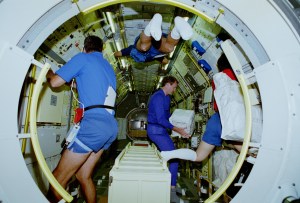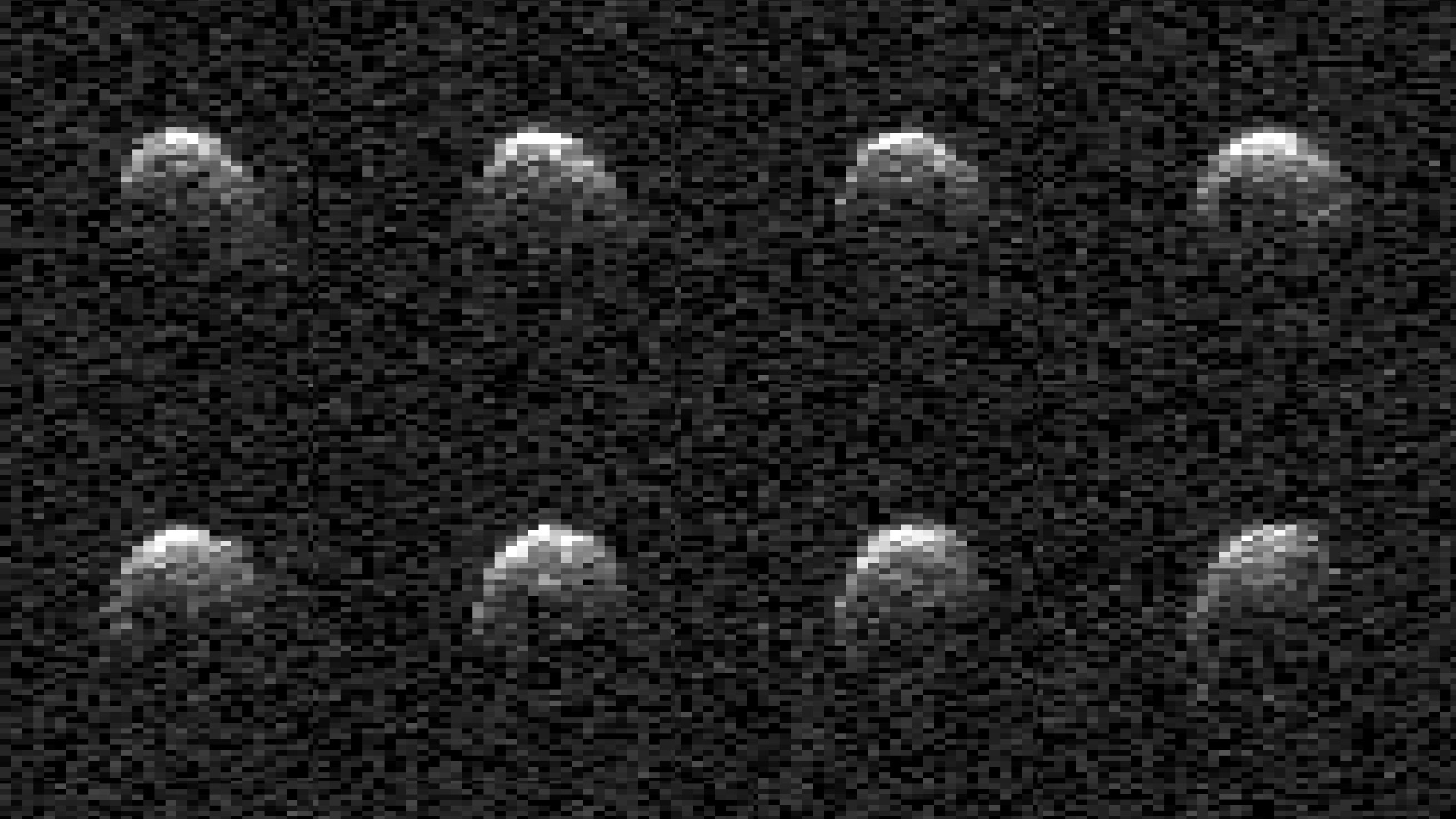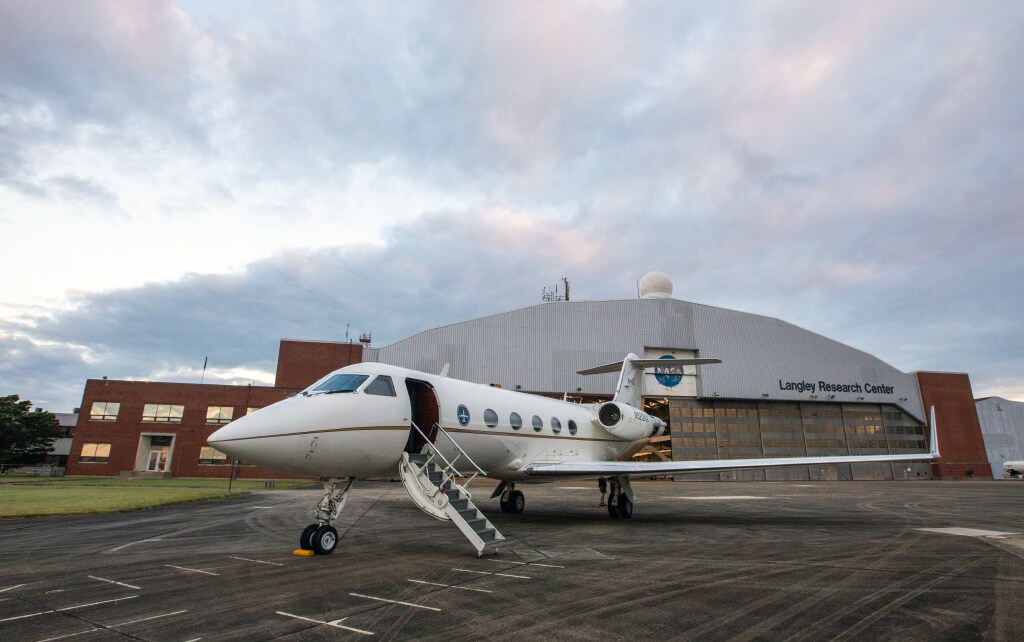15 Years Ago: STS-127 Delivers Japanese External Platform to Space Station
On July 15, 2009, space shuttle Endeavour began its 23rd trip into space, on the 2JA mission to the International Space Station, the 29th shuttle flight to the orbiting lab. During the 16-day mission, the seven-member STS-127 crew, working with Expedition 20, the first six-person crew aboard the station, completed the primary objectives of the […]
On July 15, 2009, space shuttle Endeavour began its 23rd trip into space, on the 2JA mission to the International Space Station, the 29th shuttle flight to the orbiting lab. During the 16-day mission, the seven-member STS-127 crew, working with Expedition 20, the first six-person crew aboard the station, completed the primary objectives of the mission. The flight marked the first time 13 people worked about the station at the same time. They added the Exposed Facility (EF) to the Kibo Japanese Experiment Module (JEM), including its first three payloads, and performed a crew exchange of long-duration crew members. The tasks involved five complex space walks and extensive robotic activities using three different manipulator systems during 11 days of docked operations.
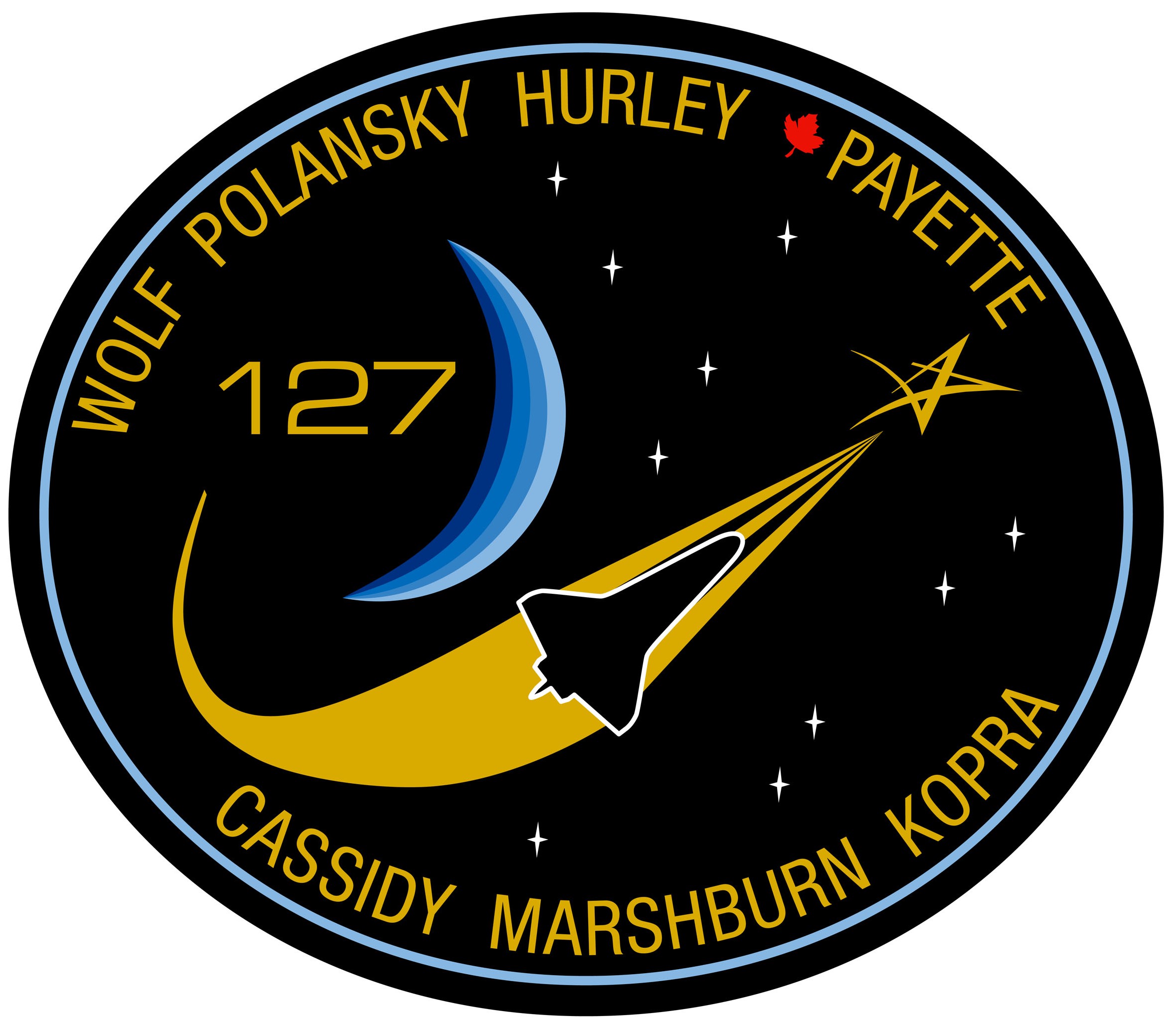
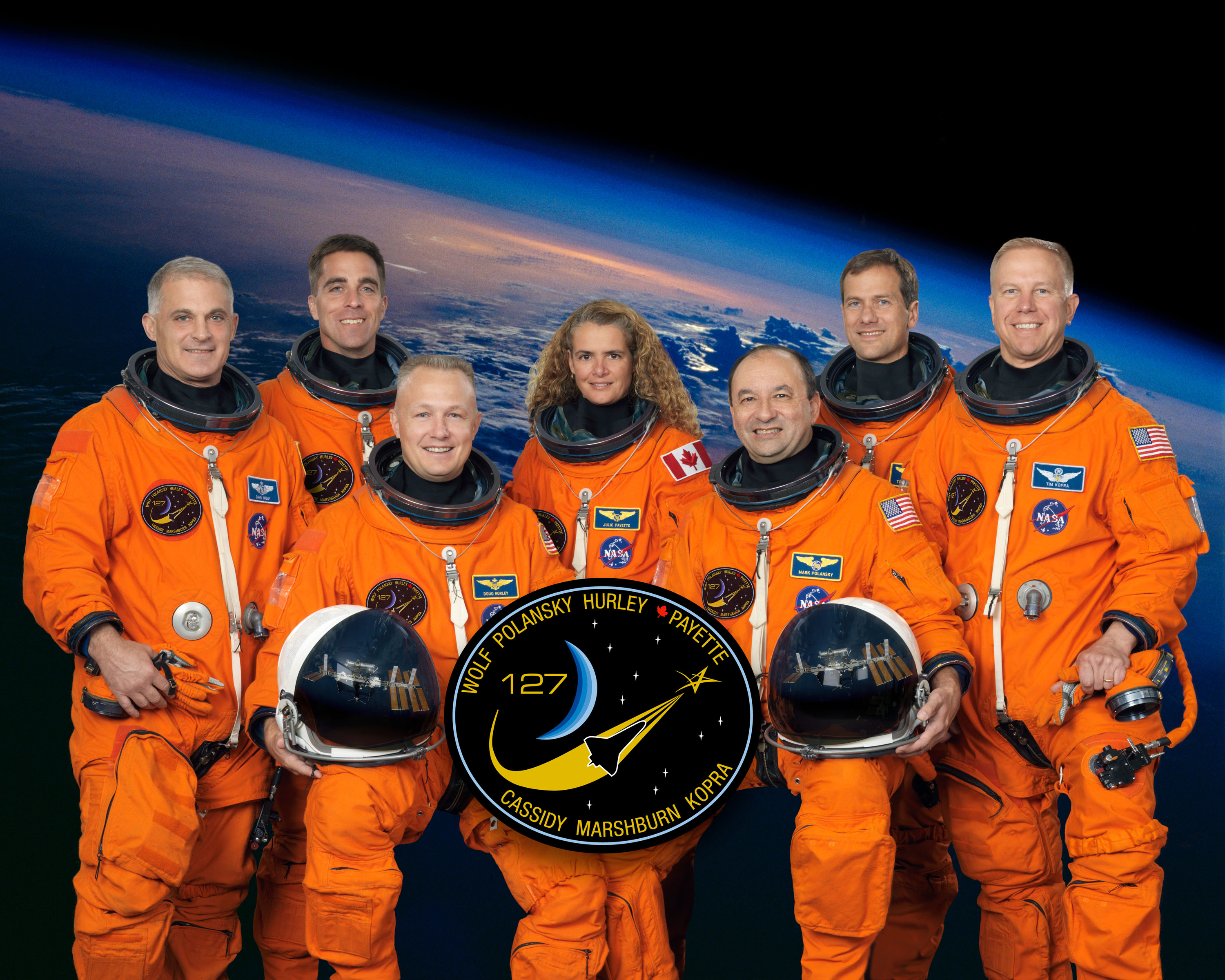

Left: The STS-127 crew patch. Middle: Official photograph of the STS-127 crew of David A. Wolf, left, Christopher J. Cassidy, Douglas G. Hurley, Julie Payette of Canada, Mark L. Polansky, Thomas H. Marshburn, and Timothy L. Kopra. Right: The patch for the 2J/A mission.
The seven-person STS-127 crew consisted of Commander Mark L. Polansky, Pilot Douglas G. Hurley, and Mission Specialists David A. Wolf, Christopher J. Cassidy, Julie Payette of the Canadian Space Agency (CSA), Thomas H. Marshburn, and Timothy L. Kopra. Primary objectives of the mission included the addition of the Exposed Facility (EF) to the Kibo Japanese Experiment Module (JEM) and the long-duration crew member exchange of Kopra for Koichi Wakata of the Japan Aerospace Exploration Agency (JAXA), who had been aboard the space station since March 2009 as a member of Expeditions 18, 19, and 20.
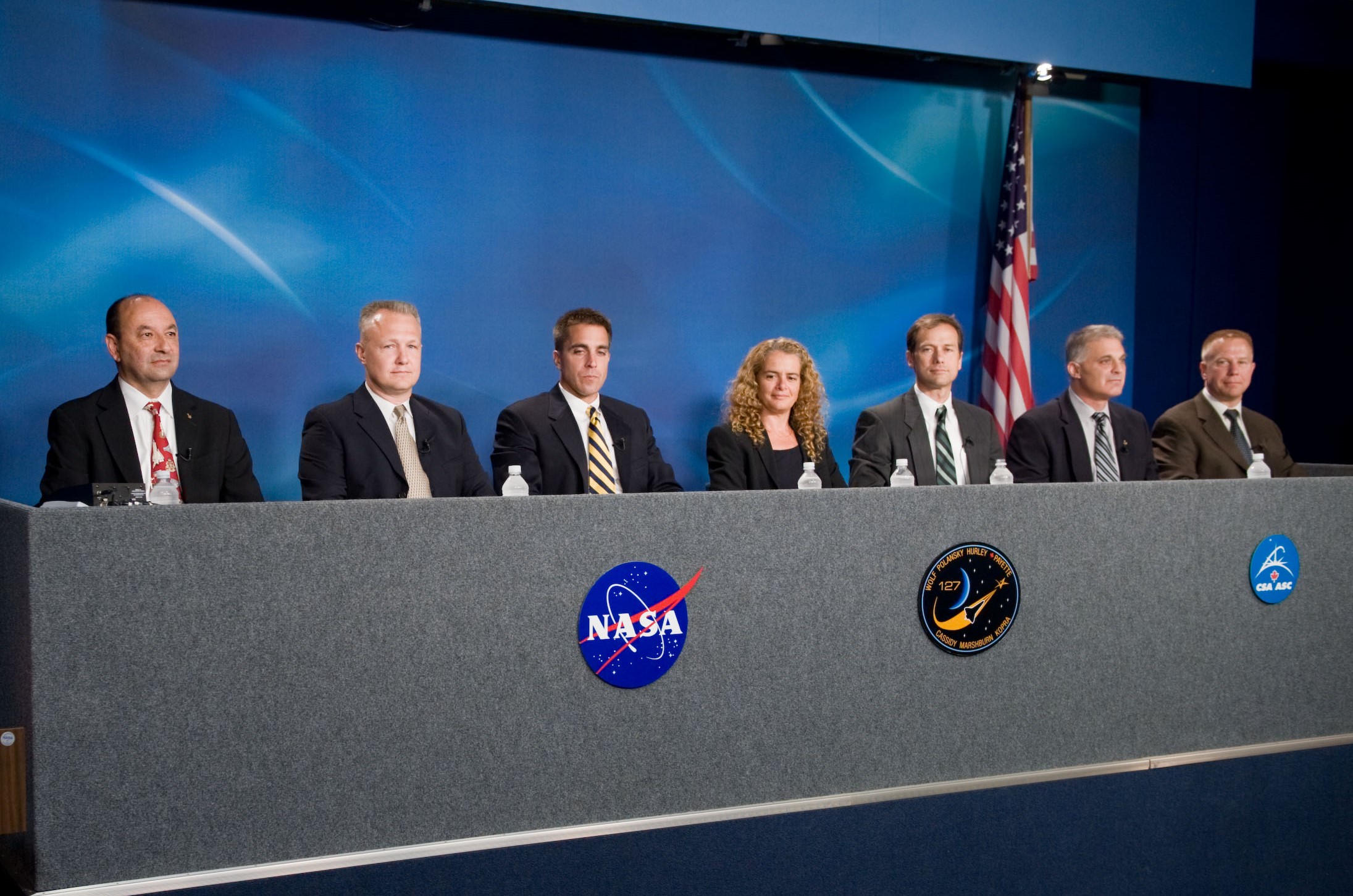
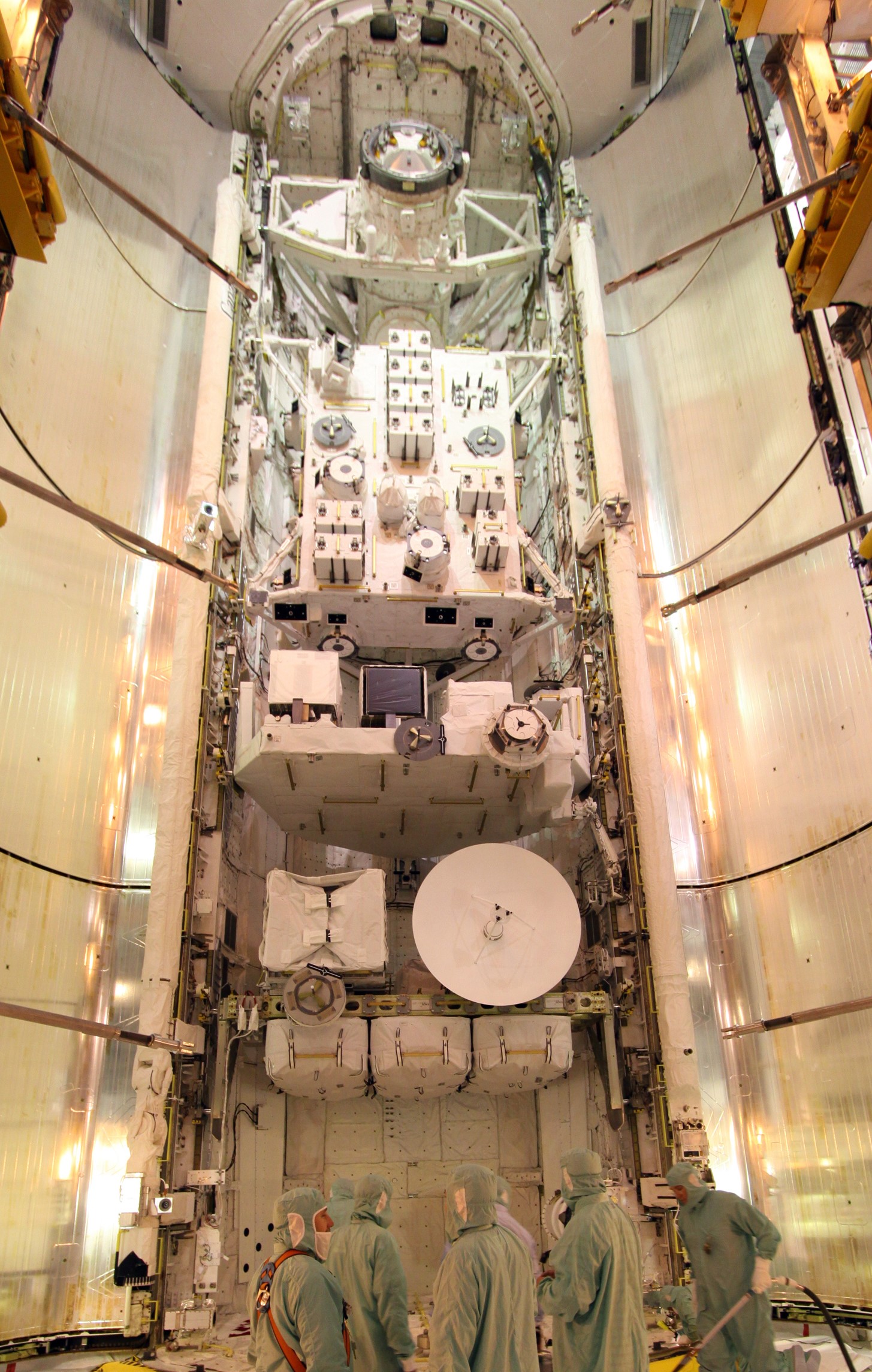
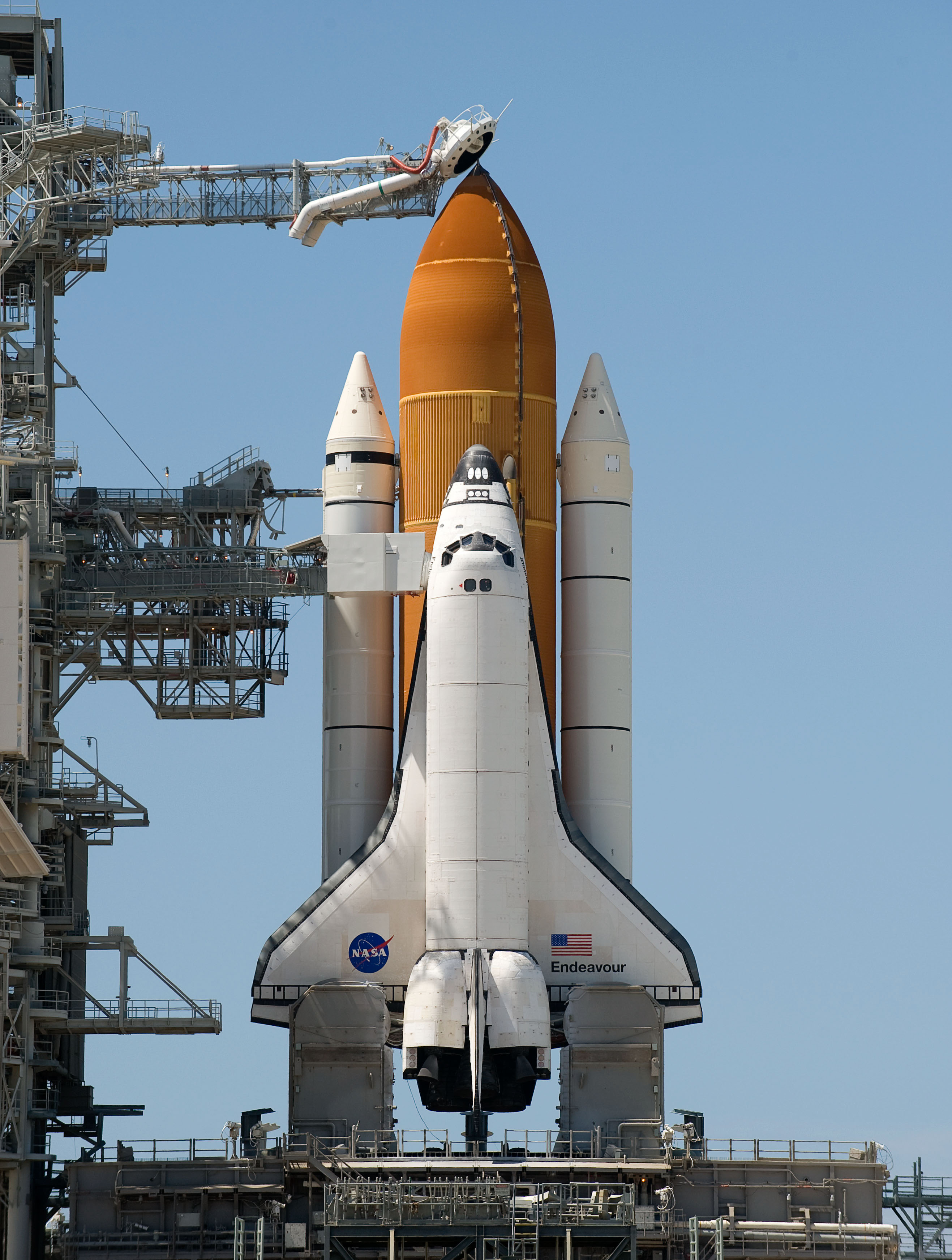
Left: The STS-127 crew during their preflight press conference at NASA’s Johnson Space Center in Houston. Middle: The STS-127 payloads in Endeavour’s cargo bay at Launch Pad 39A at NASA’s Kennedy Space Center in Florida. Right: Space shuttle Endeavour on Launch Pad 39A a few days before launch.
Endeavour returned from its previous mission, STS-126, on Nov. 28, 2008. It arrived in the Orbiter Processing Facility at NASA’s Kennedy Space Center (KSC) on Dec. 13, moved to the Vehicle Assembly Building on April 10, 2009, and rolled out to Launch Pad 39B seven days later to serve as the Launch on Need vehicle for STS-125 in May 2009. When that mission flew without issues, on May 31, workers rolled Endeavour around to Pad 39A to begin preparations for STS-127, planned for launch on June 13. A gaseous hydrogen leak scrubbed this first launch attempt. A similar leak halted the second attempt on June 17 and managers reset the launch date to July 11. Managers scrubbed that launch when 11 lightning strikes struck the launch pad area, requiring a review of Endeavour’s and ground systems. With the seven-member crew aboard Endeavour, weather once again halted the launch attempt on July 12. They tried again the next day, but weather conditions led to a fifth scrubbed launch attempt. The charm came on the sixth try.
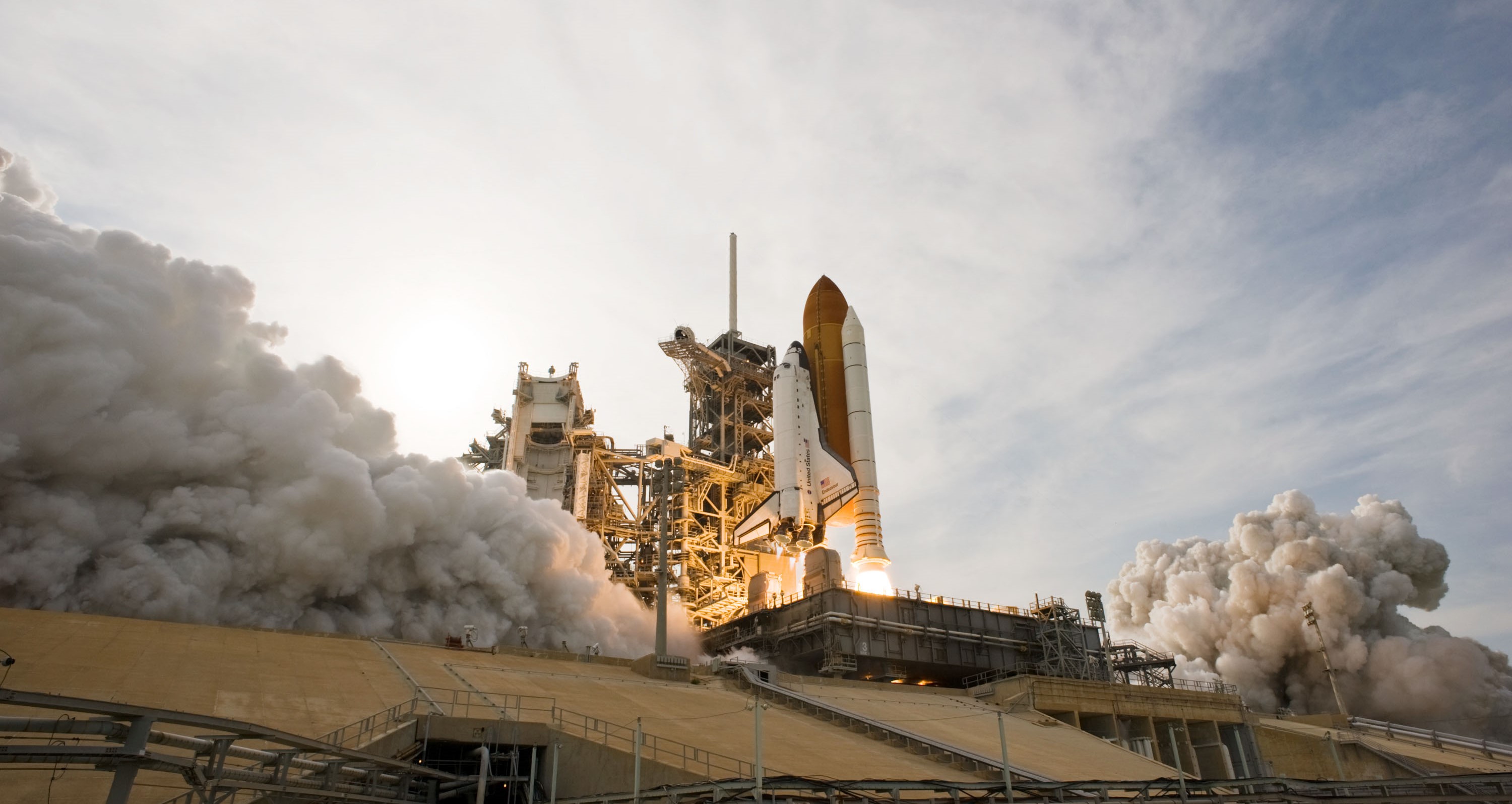
Liftoff of space shuttle Endeavour on STS-127 carrying the Exposed Facility for the Japanese Kibo module.
On July 15, 2009, at 6:03 p.m. EDT, space shuttle Endeavour lifted off from KSC’s Launch Pad 39A to begin its 23rd trip into space, beginning the 2JA mission to the space station. Eight and a half minutes later, Endeavour and its crew had reached orbit. This marked Wolf’s fourth time in space, Polansky’s third, Payette’s second, while Hurley, Cassidy, Marshburn, and Kopra enjoyed their first taste of true weightlessness.
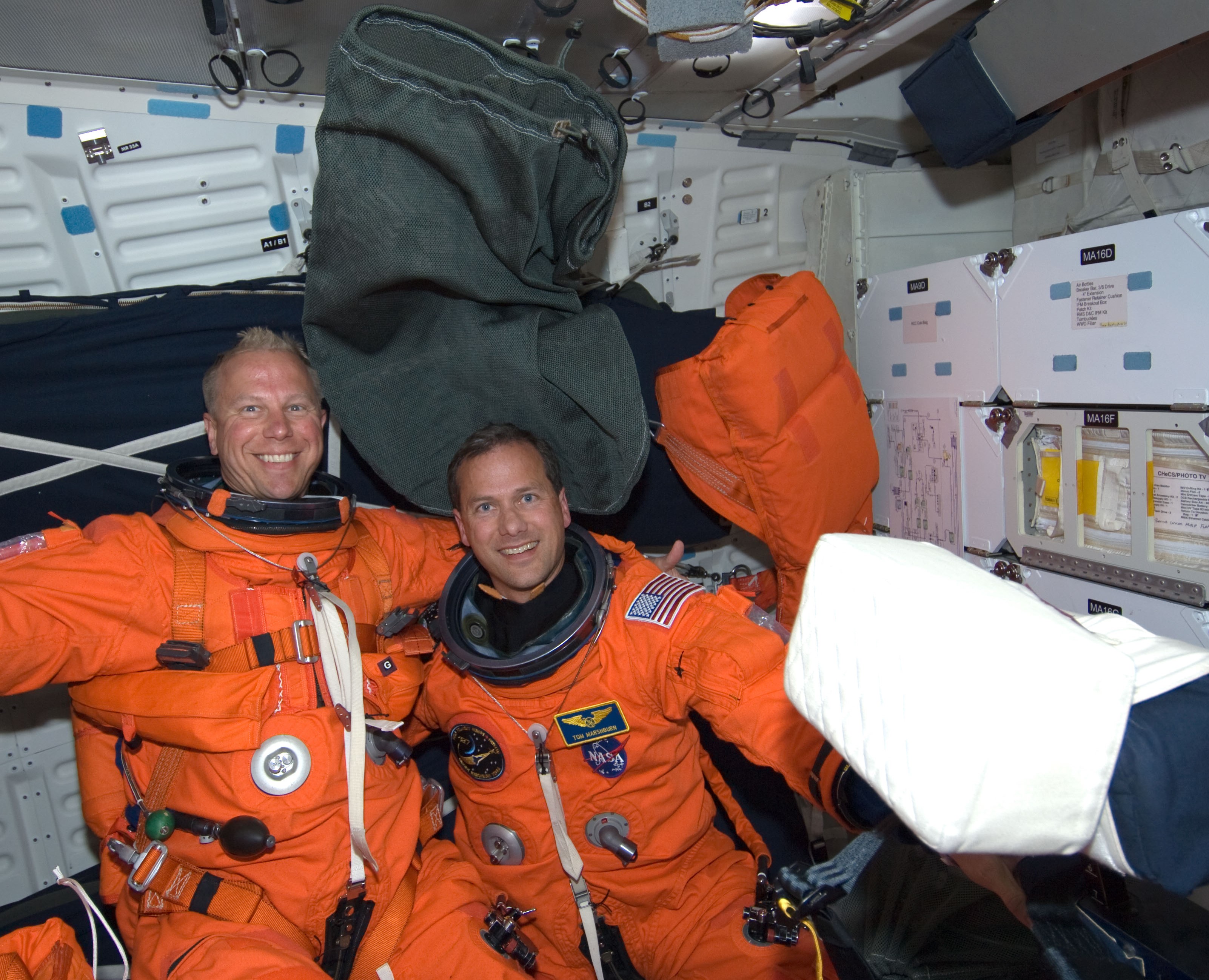


Left: NASA astronauts Timothy L. Kopra, left, and Thomas H. Marshburn enjoy the first few minutes of weightlessness after Endeavour reached orbit. Middle: On the mission’s second day, the Shuttle Remote Manipulator System (SRMS) uses the Orbiter Boom Sensor System to image Endeavour’s Thermal Protection System (TPS). Right: Canadian Space Agency astronaut Julie Payette operates the SRMS during the TPS inspection.
After reaching orbit, the crew opened the payload bay doors and deployed the shuttle’s radiators, and removed their bulky launch and entry suits, stowing them for the remainder of the flight. The astronauts spent five hours on their second day in space conducting a detailed inspection of Endeavour’s nose cap and wing leading edges, with Payette operating the Shuttle Remote Manipulator System (SRMS), or robotic arm, and the Orbiter Boom Sensor System (OBSS).
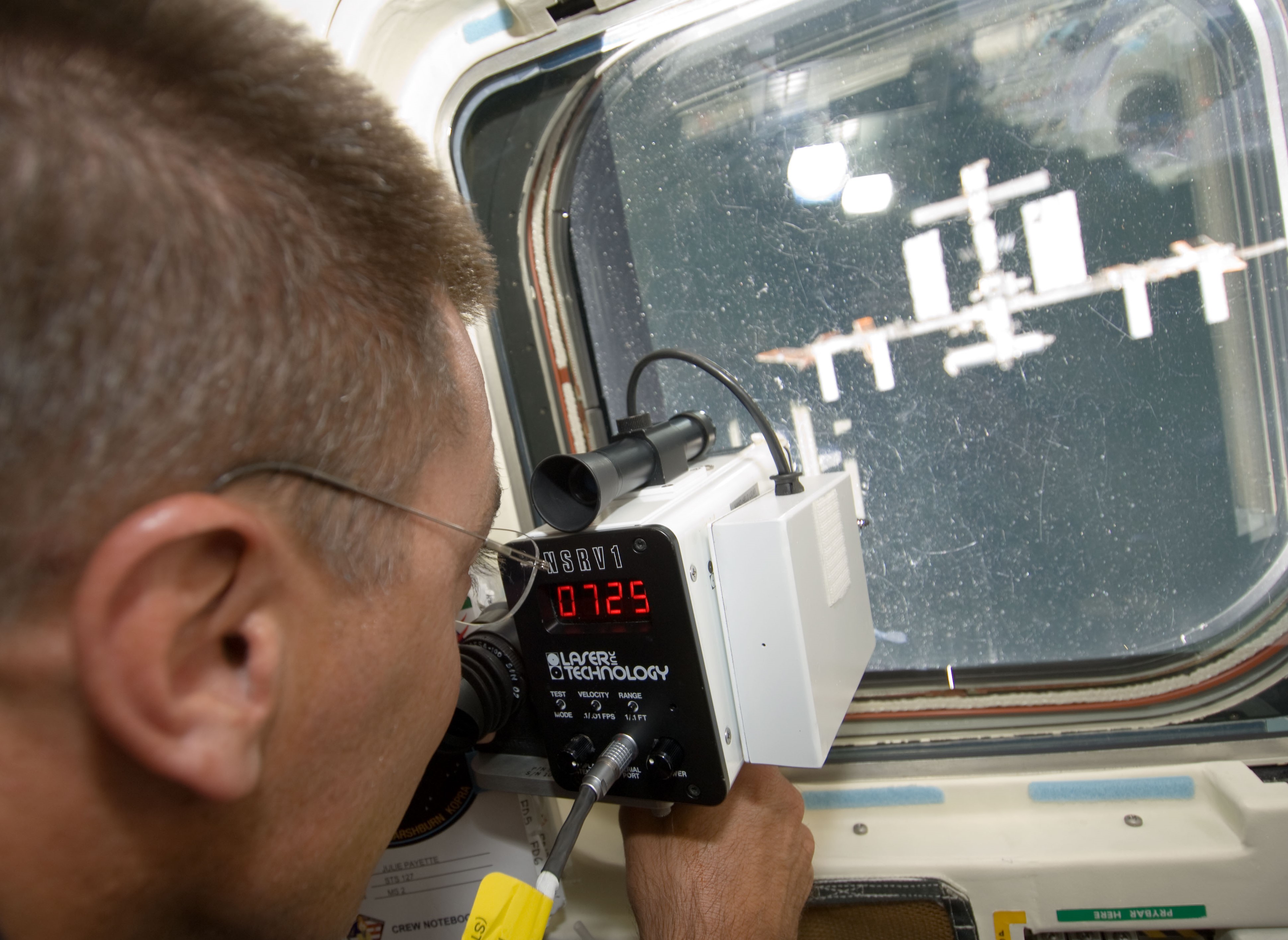

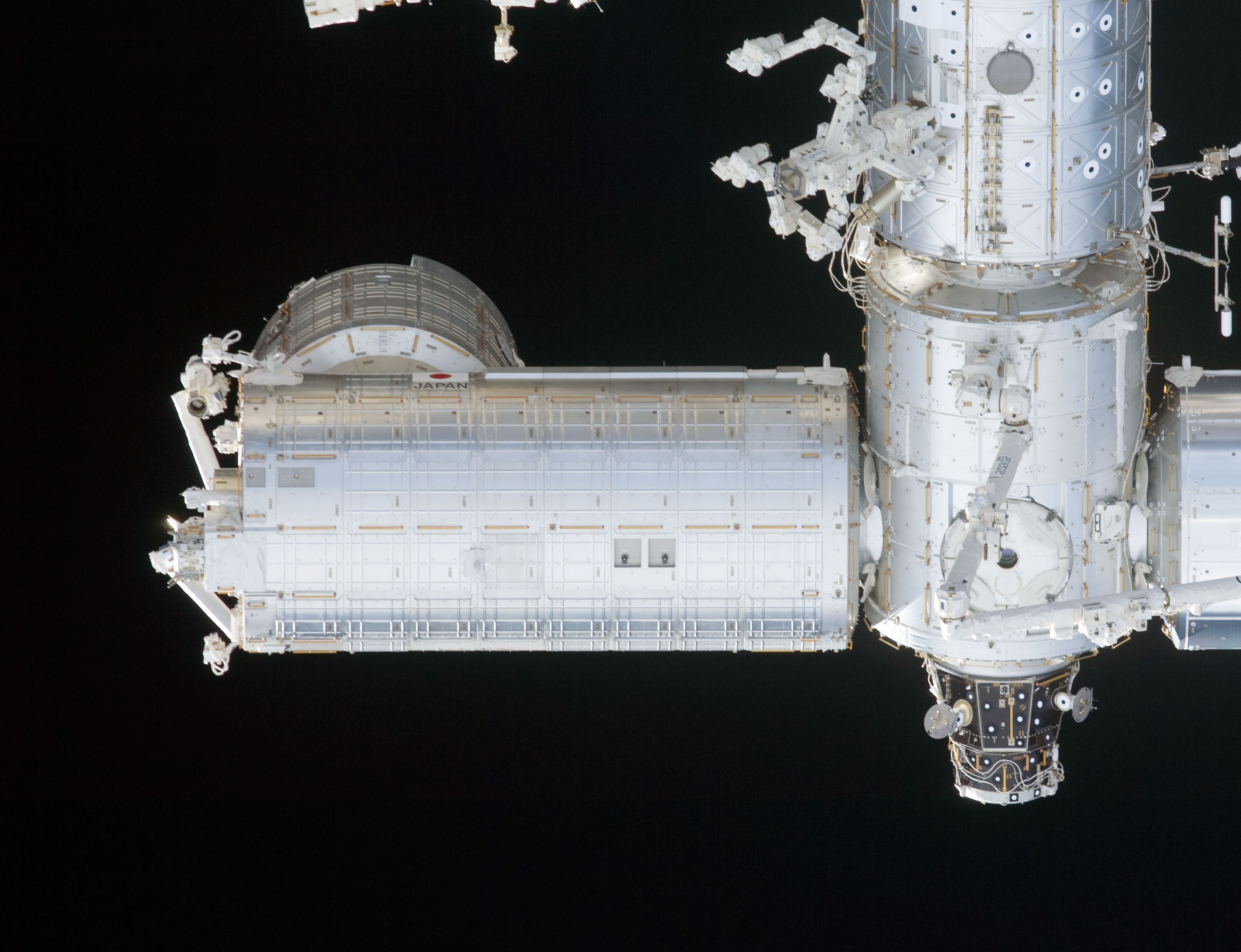
Left: NASA astronaut Christopher J. Cassidy uses a laser range finder during Endeavour’s rendezvous with the space station. Middle: Endeavour as seen from the space station during the rendezvous. Right: Close up of the Kibo Japanese Experiment Module – the astronauts attached the Exposed Facility at the left end of the module.
On July 17, the 34th anniversary of the Apollo-Soyuz Test Project docking, Polansky assisted by his crewmates brought Endeavour in for a docking with the space station. During the rendezvous, Polansky stopped the approach at 600 feet and completed the Rendezvous Pitch Maneuver so astronauts aboard the station could photograph Endeavour’s underside to look for any damage to the tiles. Shortly after docking, the crews opened the hatches between the two spacecraft and the six-person station crew welcomed the seven-member shuttle crew. Expedition 20 Commander Gennady I. Padalka of Roscosmos stated, “This is a remarkable event for the whole space program.” Polansky responded, “Thirteen is a big number, but we are thrilled to be here.” After exchanging Soyuz seat liners, Kopra joined the Expedition 20 crew and Wakata the STS-127 crew.

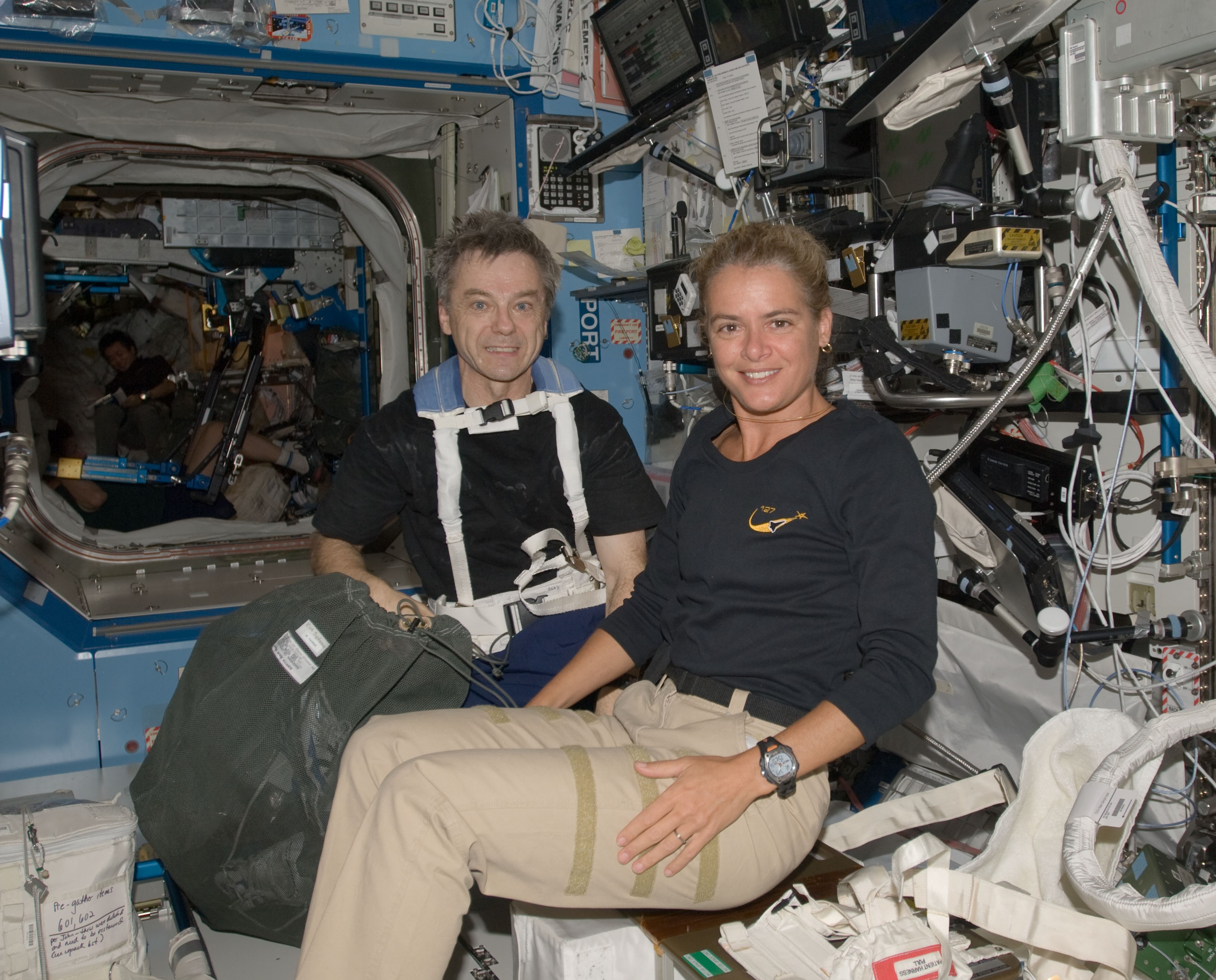
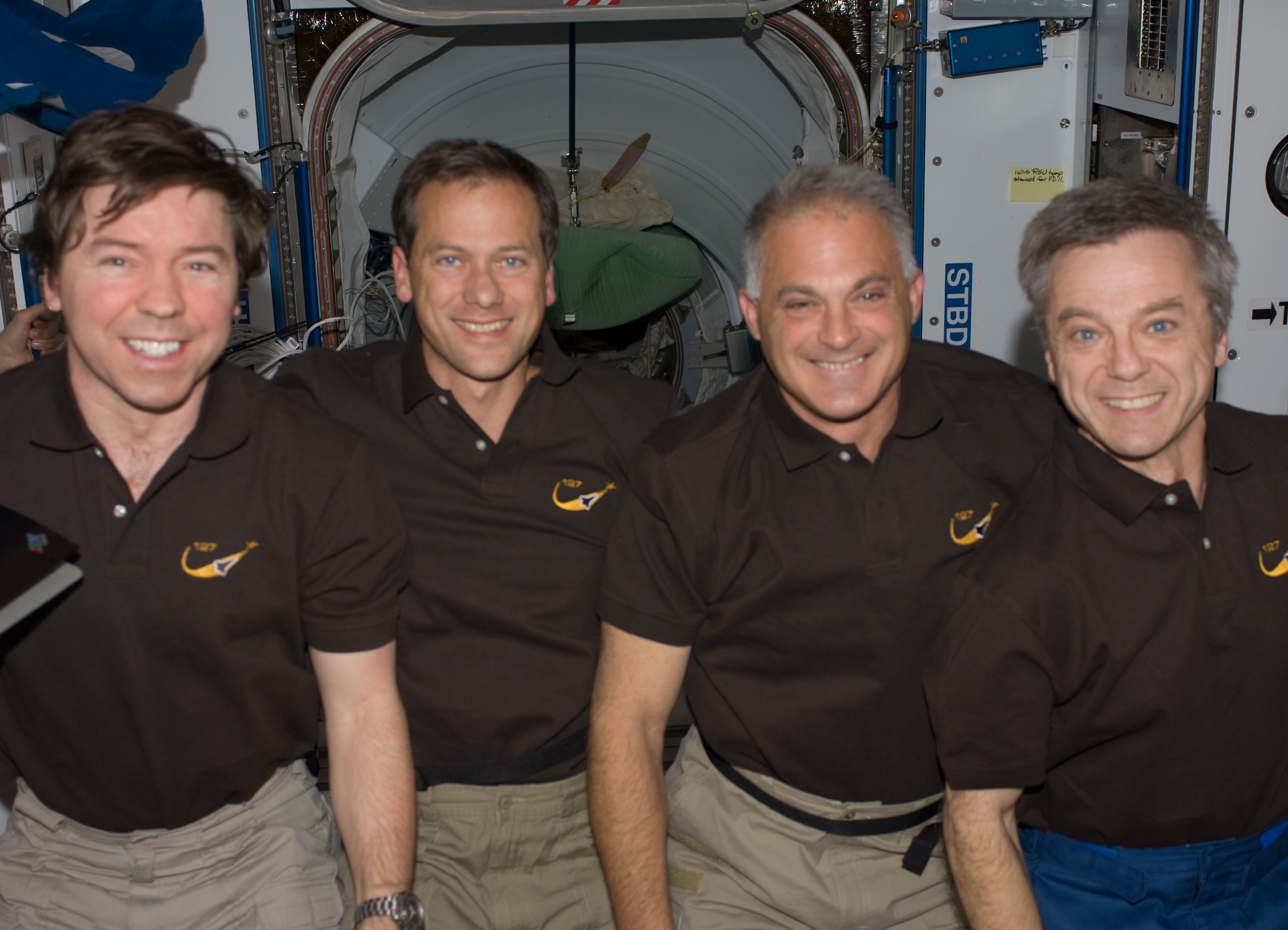
Left: Expedition 20, the space station’s first six-person crew and the first, and so far only, time that each of the five space station partners had crew members on board at the same time. Middle: The first time two Canadians were in space at the same time. Right: A medical convention in space – the first time four medical doctors flew in space at the same time.
STS-127 marked not only the first time that a space shuttle arrived at the station with a six-person crew living aboard, but as it happened, each of the five space station partners had a crew member aboard, a feat not repeated since. The flight also marked the first time that two CSA astronauts worked aboard the space station at the same time. And for the true trivia buffs, the mission marked the first time that four medical doctors worked in space together – an out of this world medical convention!
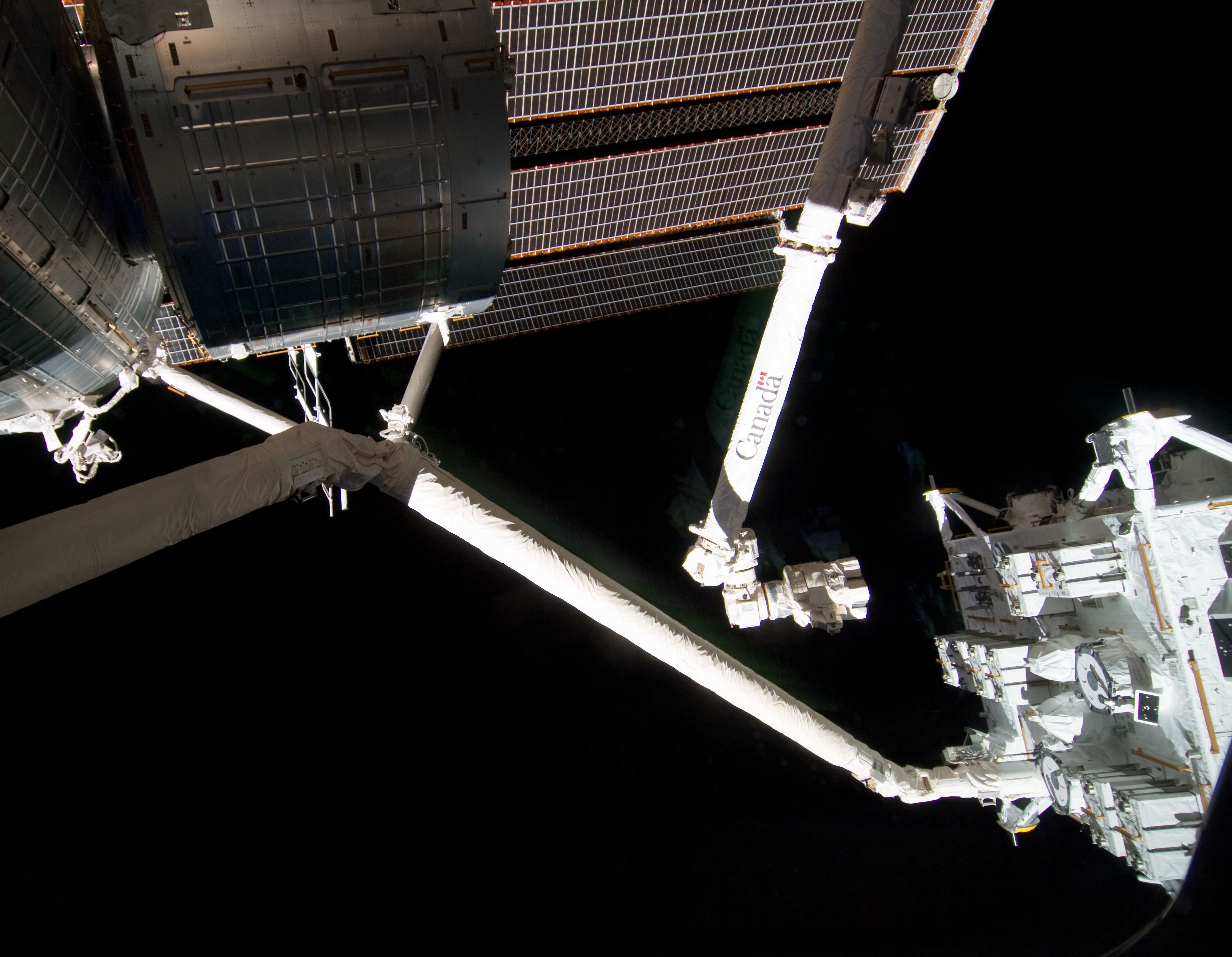


Left: Transfer of the Exposed Facility from the shuttle to the station. Middle: Timothy L. Kopra, left, and David A. Wolf work on the station’s truss during the mission’s first spacewalk. Right: Douglas G. Hurley, left, and Koichi Wakata of the Japan Aerospace Exploration Agency operate the station’s robotic arm during the first spacewalk.
On July 18, the mission’s fourth day, Hurley and Wakata grappled the JEM-EF using the Space Station Remote Manipulator System (SSRMS) or robotic arm, handed it off temporarily to the SRMS operated by Polansky and Payette, moved the station arm into position to grapple it again, and installed it on the end of the Kibo module. Meanwhile, Wolf, with red stripes on his spacesuit, and Kopra, wearing a suit with no stripes, began the mission’s first spacewalk. During the excursion that lasted 5 hours 32 minutes, Wolf and Kopra prepared the JEM for the EF installation and performed other tasks in the shuttle’s payload bay and on the station.
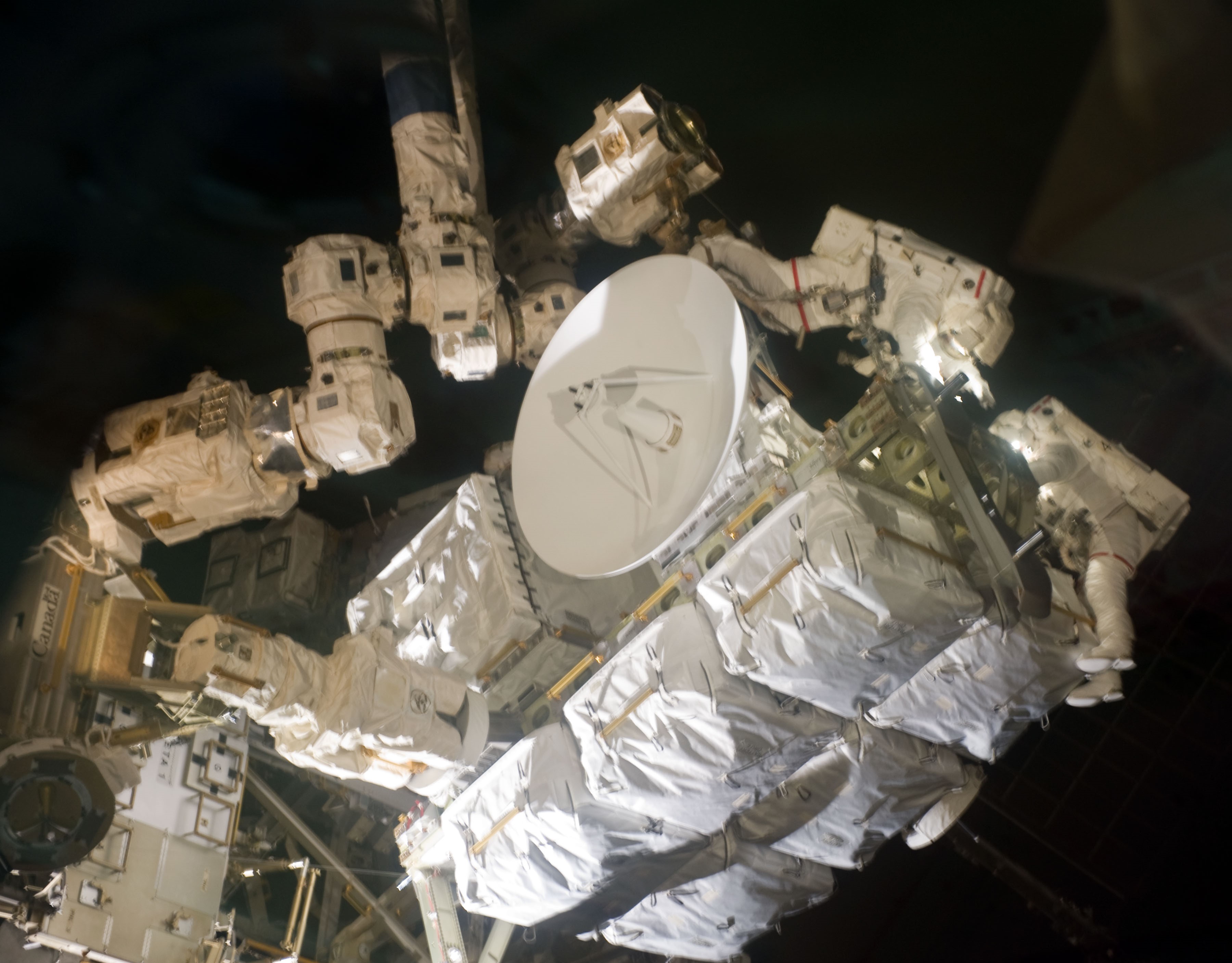
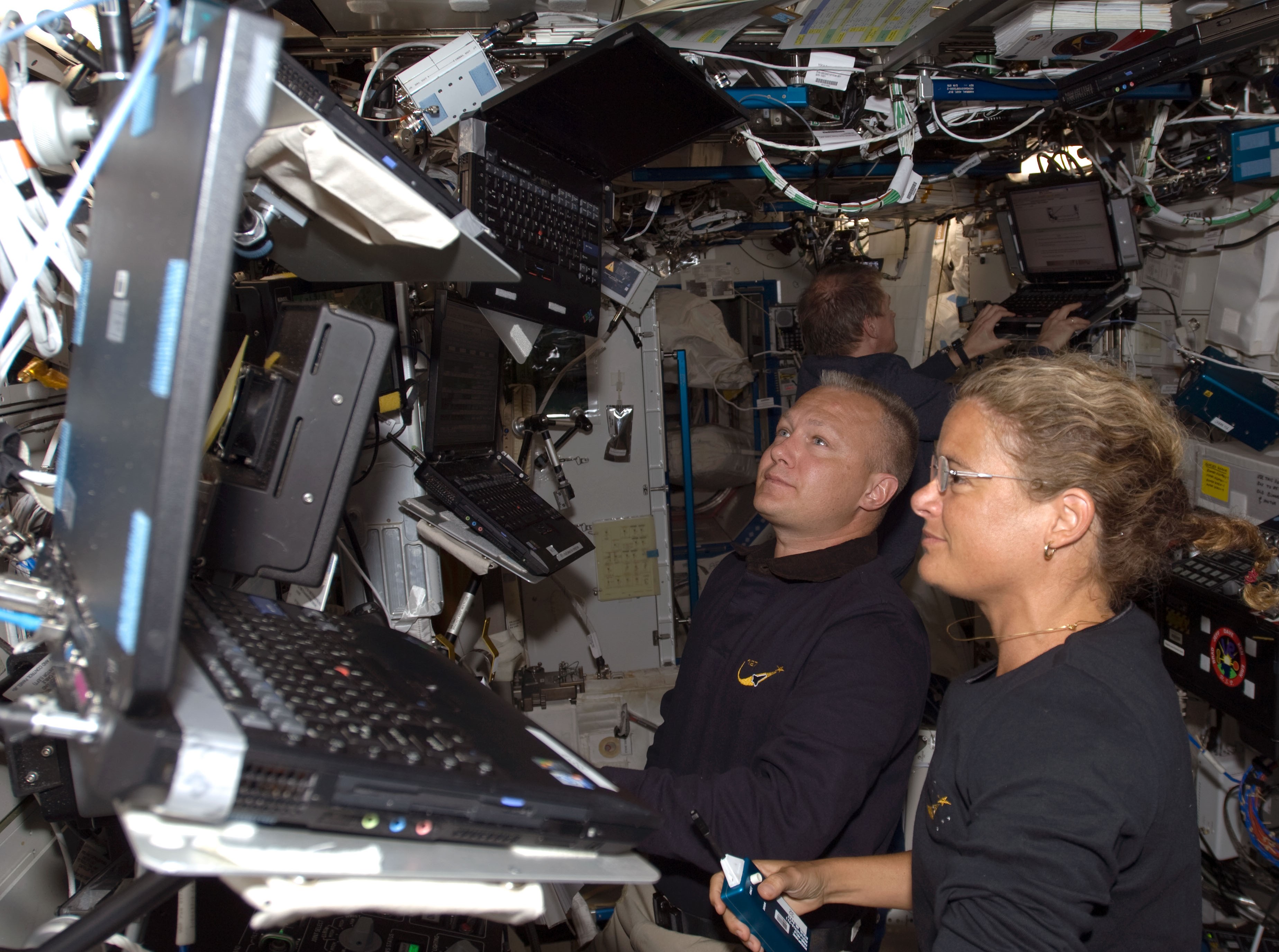
Left: During the second spacewalk, David A. Wolf, left, and Thomas H. Marshburn transfer spare parts to the space station. Right: NASA astronaut Douglas G. Hurley, left, and Canadian Space Agency astronaut Julie Payette operate the station’s robotic arm during the second spacewalk.
The mission’s fifth day involved internal transfers of equipment from the shuttle to the station and the robotic transfer of the Integrated Cargo Carrier (ICC) from the payload bay to the station truss. The ICC carried spare parts that the next day Wolf and Marshburn, wearing dashed red stripes on his spacesuit, transferred to a stowage platform on the station’s exterior during the mission’s second spacewalk, lasting 6 hours and 53 minutes.
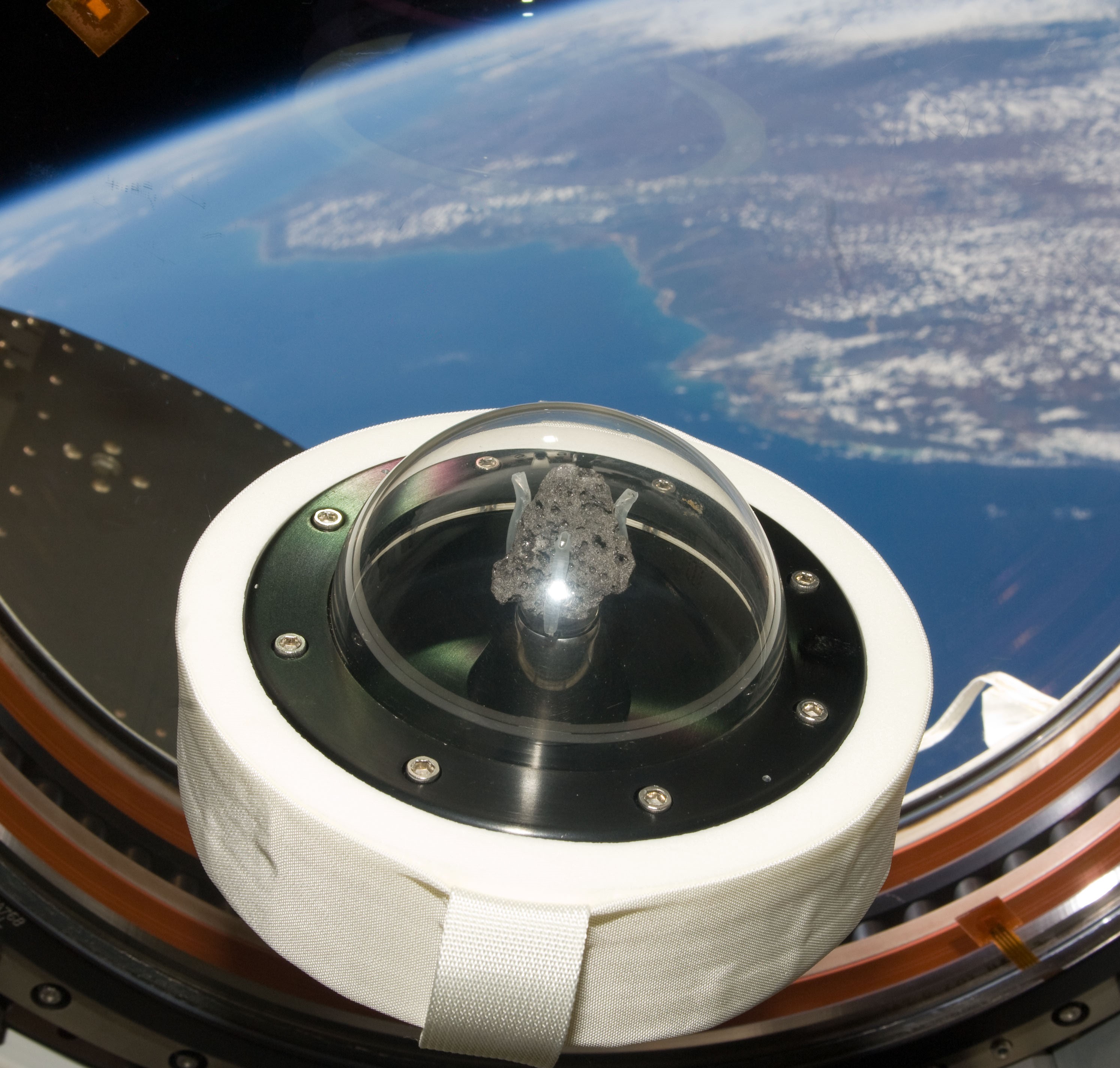
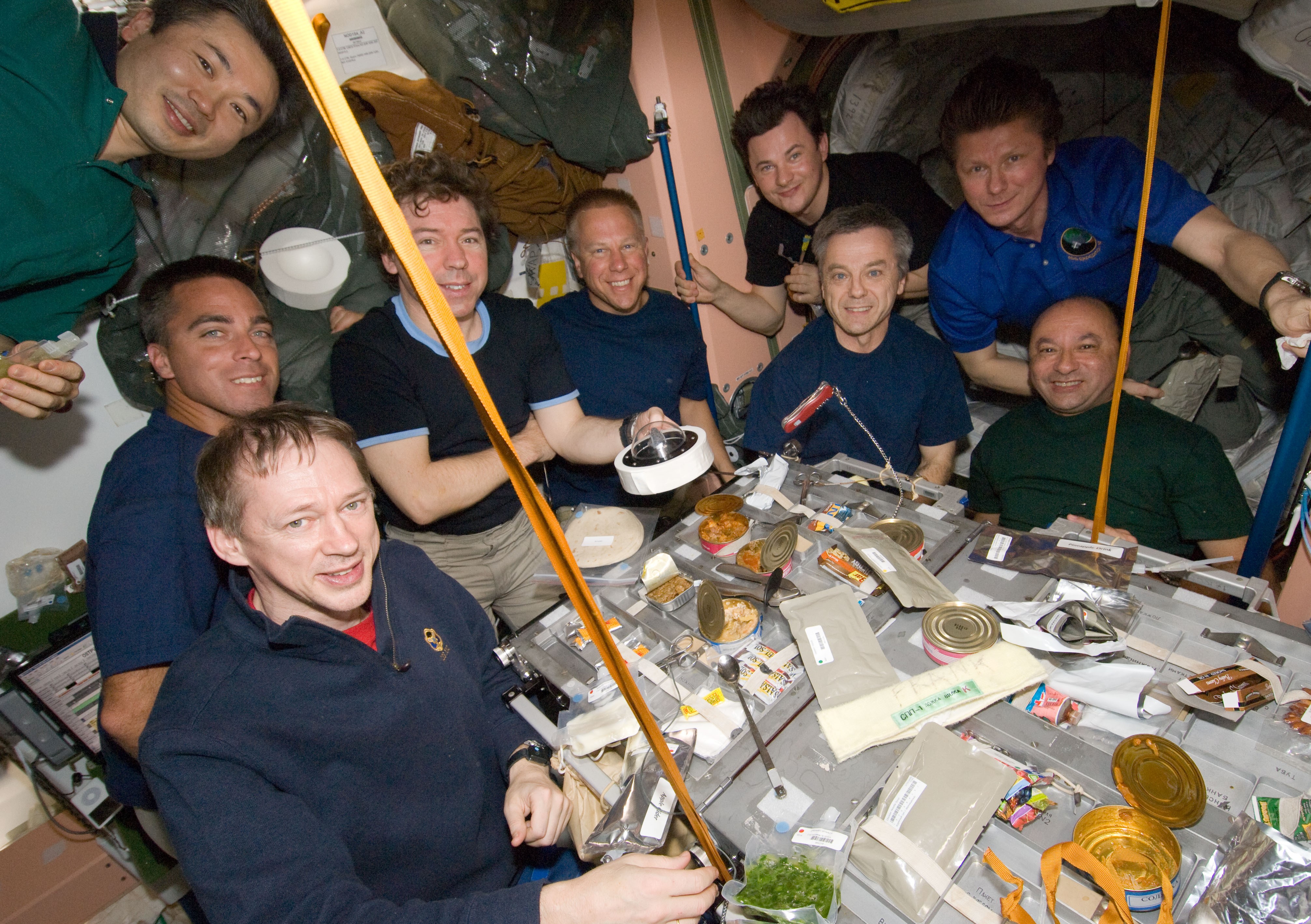
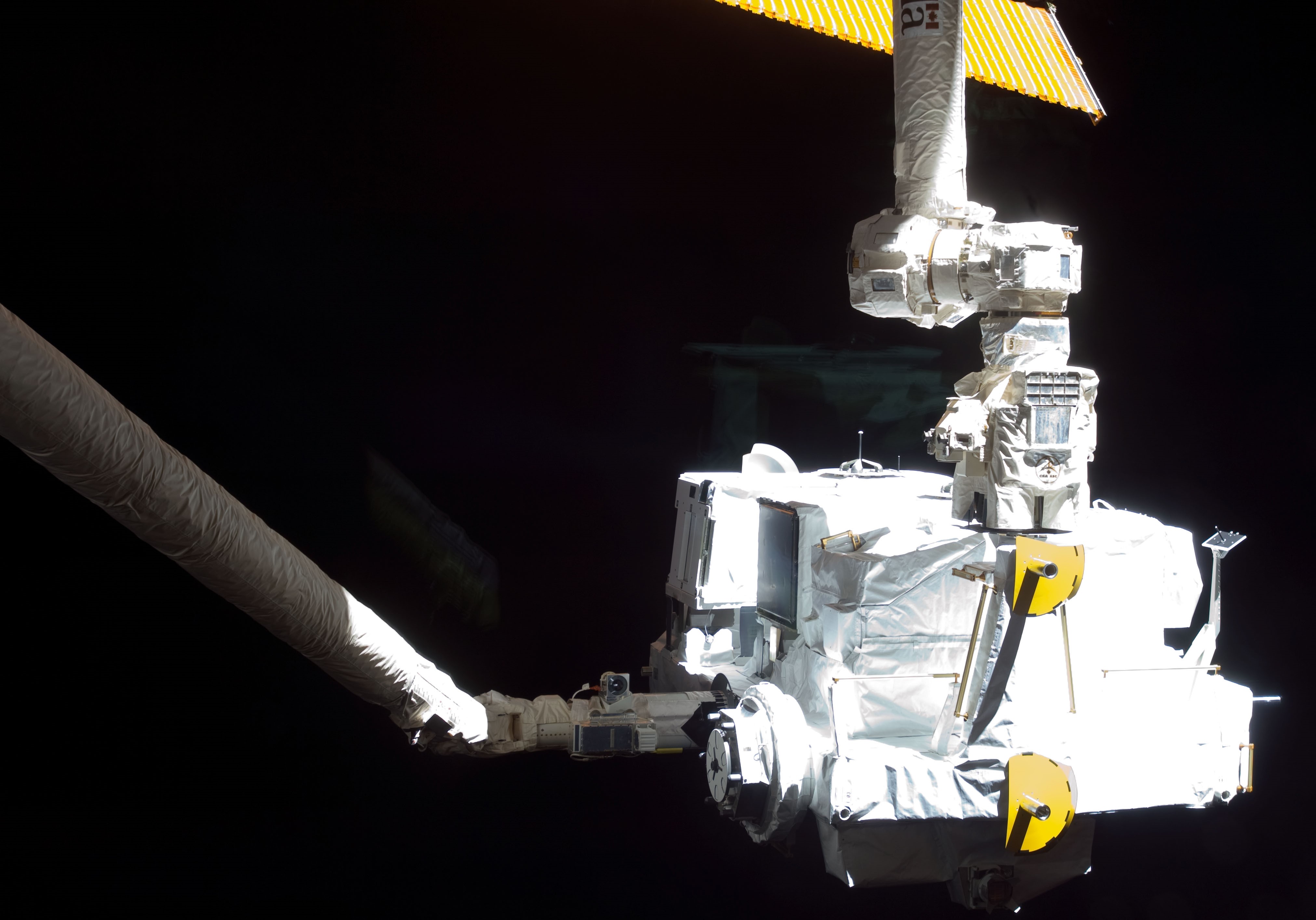
Left: An Apollo 11 Moon rock brought to the station to commemorate the 40th anniversary of the first Moon landing. Middle: Nine of the 13 Expedition 20 and STS-127 crew members share a meal, as NASA astronaut Michael R. Barratt holds the Apollo 11 Moon rock. Right: Transfer of the Kibo Experiment Logistics Module from the shuttle to the station.
The second spacewalk took place on July 20, the 40th anniversary of Apollo 11 landing on the Moon. To commemorate the event, NASA selected a Moon rock returned on that mission and flew it to the space station on STS-119 in March 2009. Expedition 20 astronaut Michael Barratt recorded a video message about the Moon rock, played at a 40th anniversary celebration hosted by the National Air and Space Museum in Washington, D.C., and attended by the Apollo 11 astronauts. The following day, the joint crews continued their work by robotically transferring the JEM Experiment Logistics Module (JEM ELM) and temporarily installing it on the Exposed Facility. Later in the mission, astronauts robotically transferred the three payloads from the ELM to EF.
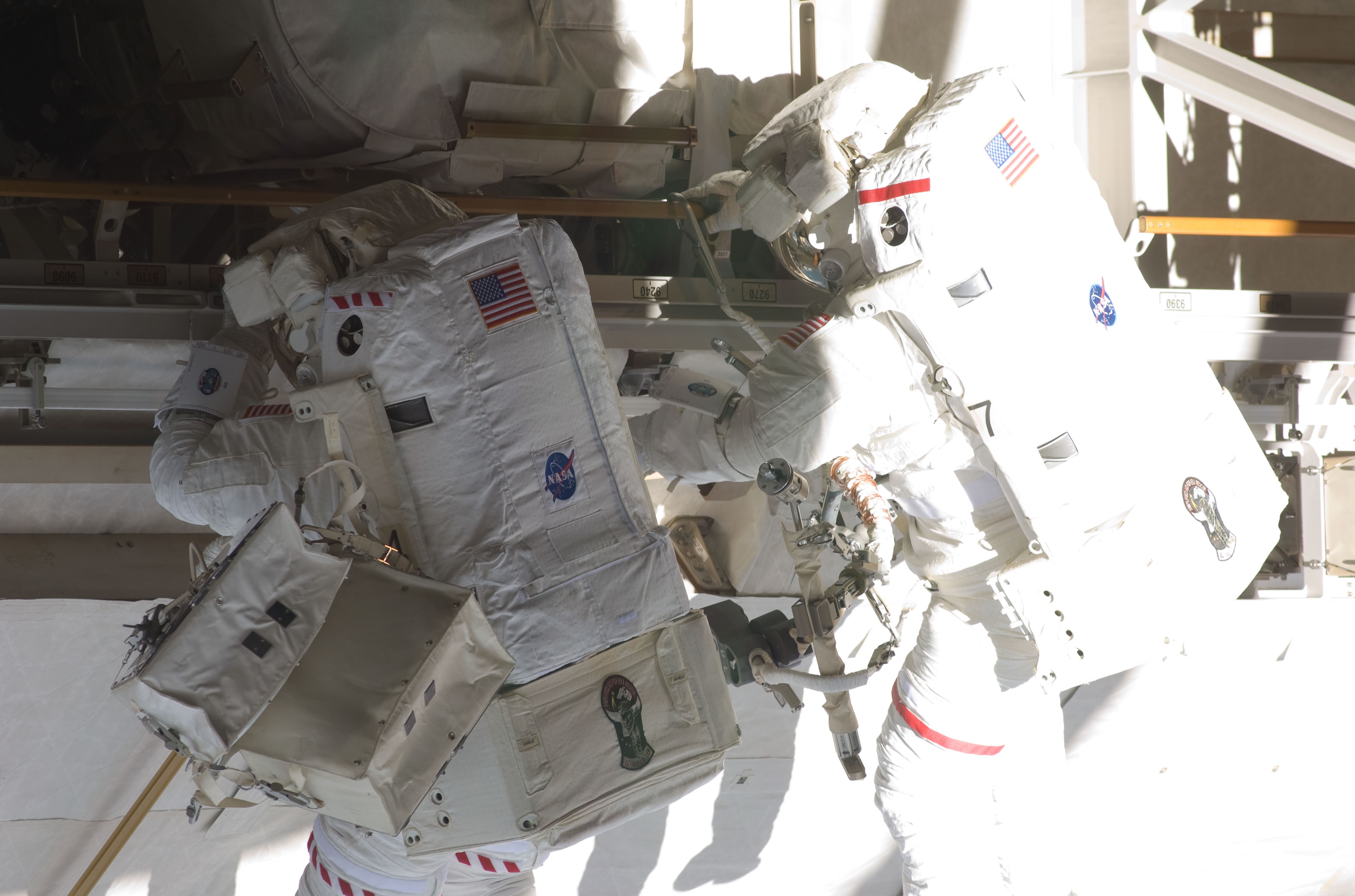
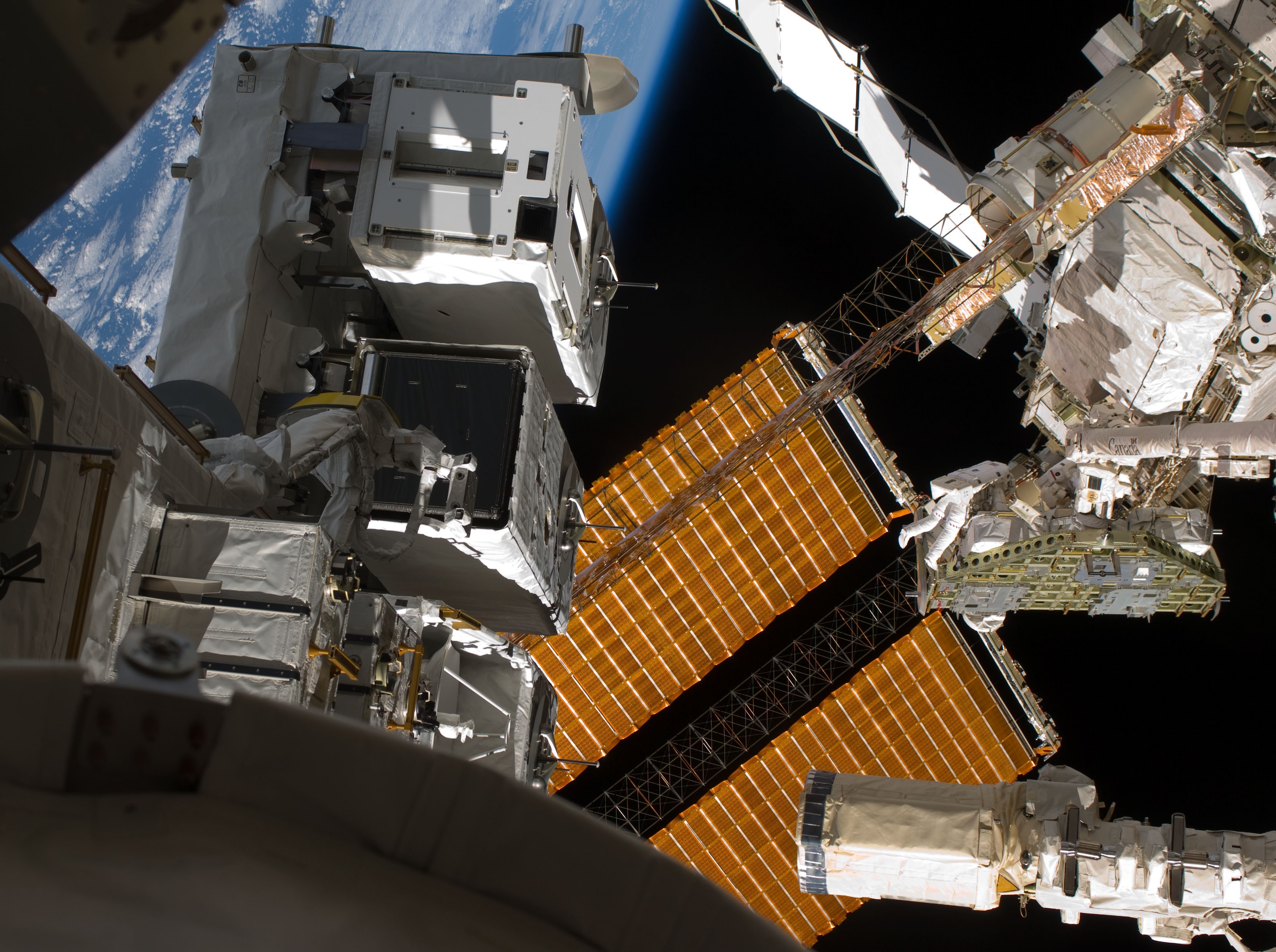
Left: Christopher J. Cassidy, left, and David A. Wolf during the mission’s third spacewalk. Right: Cassidy, left, and Wolf during a battery changeout.
Flight Day 8 saw the mission’s third spacewalk, with Wolf making his final excursion, this time accompanied by Cassidy, wearing diagonal red stripes on his suit. Prior to the start of the spacewalk, Hurley and Payette used the station’s arm to relocate the ICC to a different workstation for Wolf and Cassidy to transfer the batteries to the station. As their first task, Wolf and Cassidy prepared the JEM EF for the transfer of the three payload the following day. They managed to transfer two of the four batteries before mission managers decided to shorten the spacewalk due to a slight buildup of carbon dioxide in Cassidy’s suit. The excursion lasted 5 hours and 59 minutes.
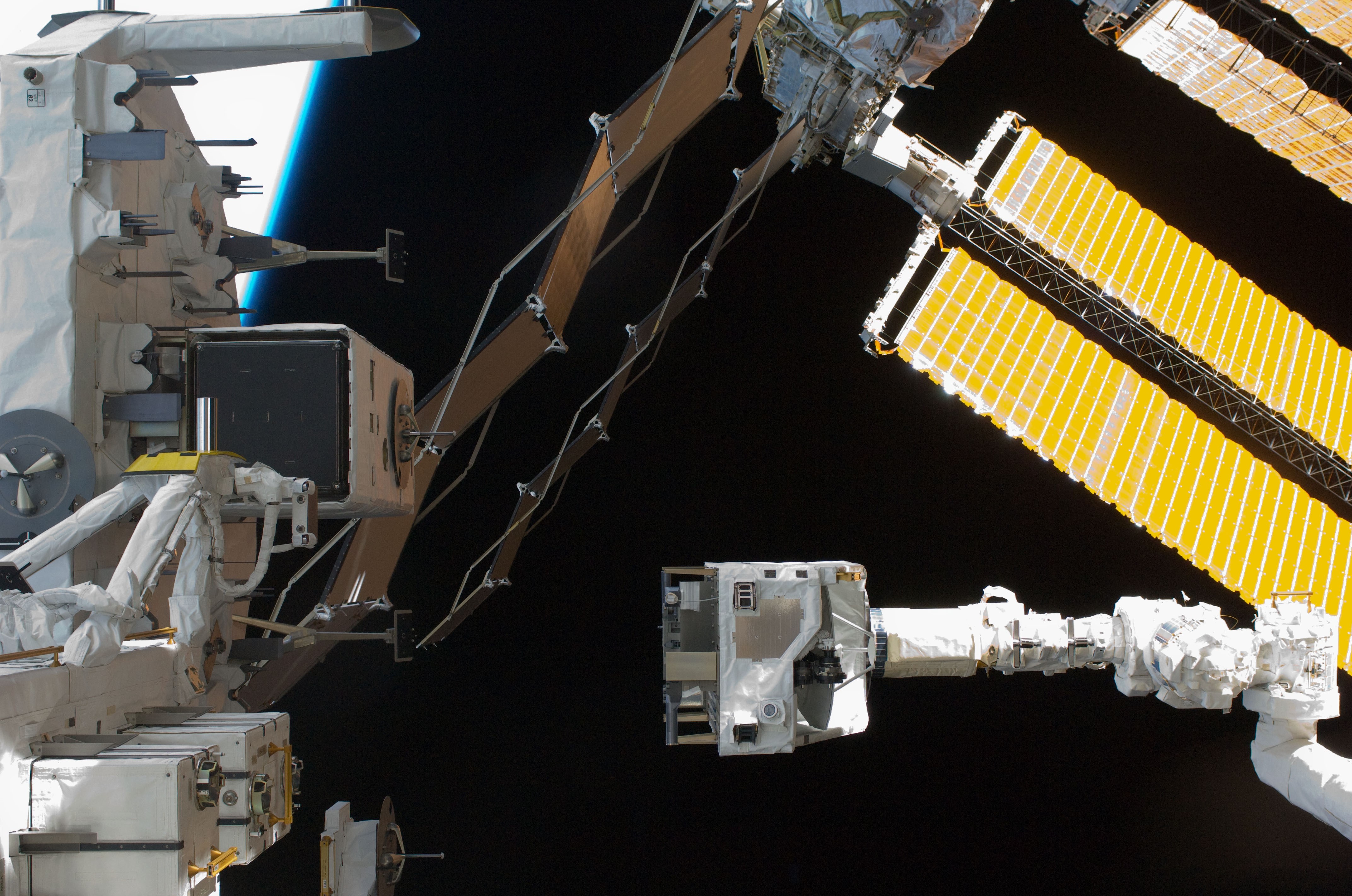
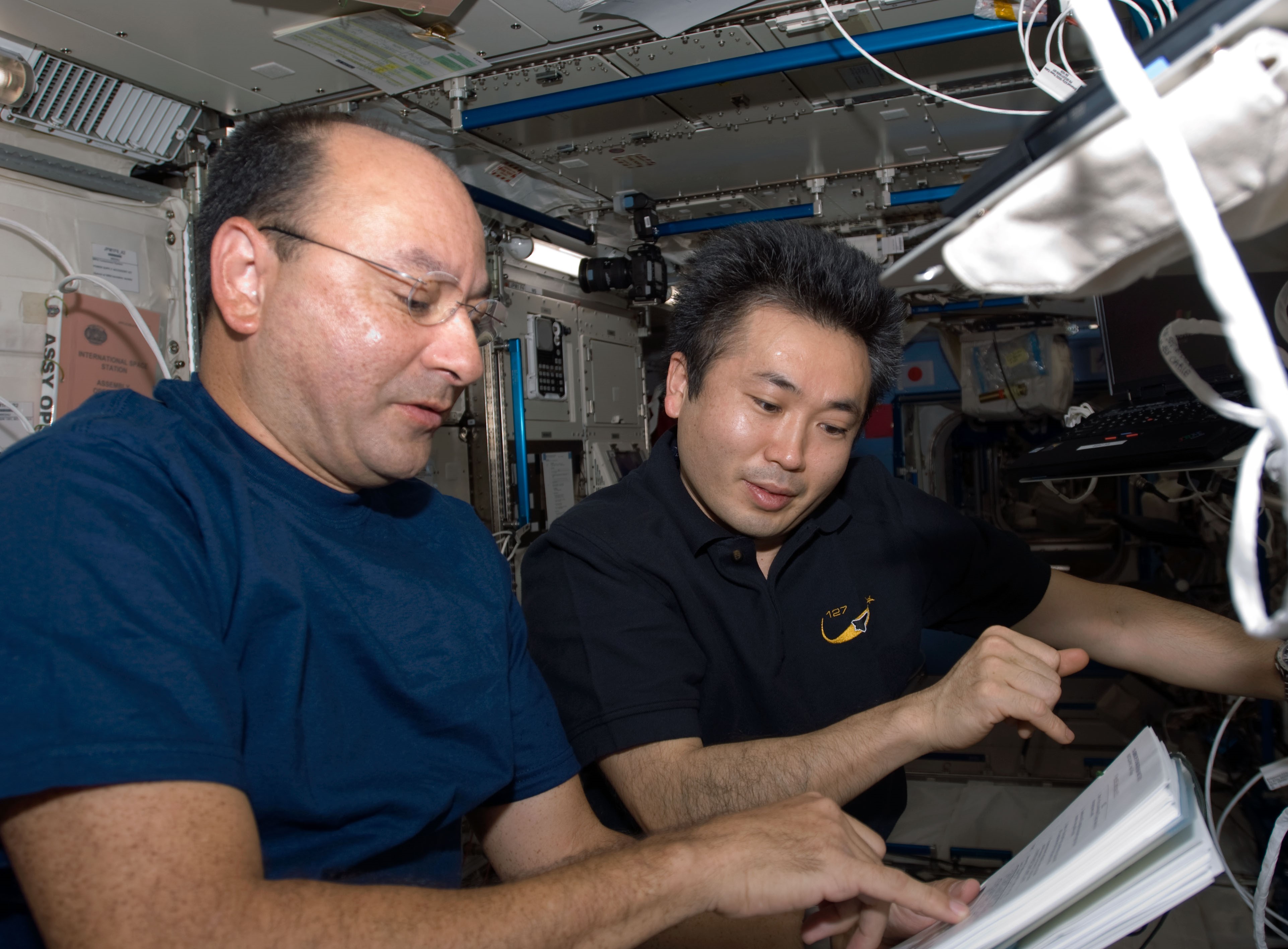
Left: Installation of one of the payloads onto the Kibo Exposed Facility (EF). Right: Mark J. Polansky, left, and Koichi Wakata of the Japan Aerospace Exploration Agency, one of the three teams that transferred the EF payloads using Kibo’s robotic arm.
On Flight Day 9, Wakata, assisted by Kopra, inaugurated the operational use of the JEM’s robotic arm by transferring the first payload from the ELM to the EF. Three separate two-person teams transferred each of the three payloads.
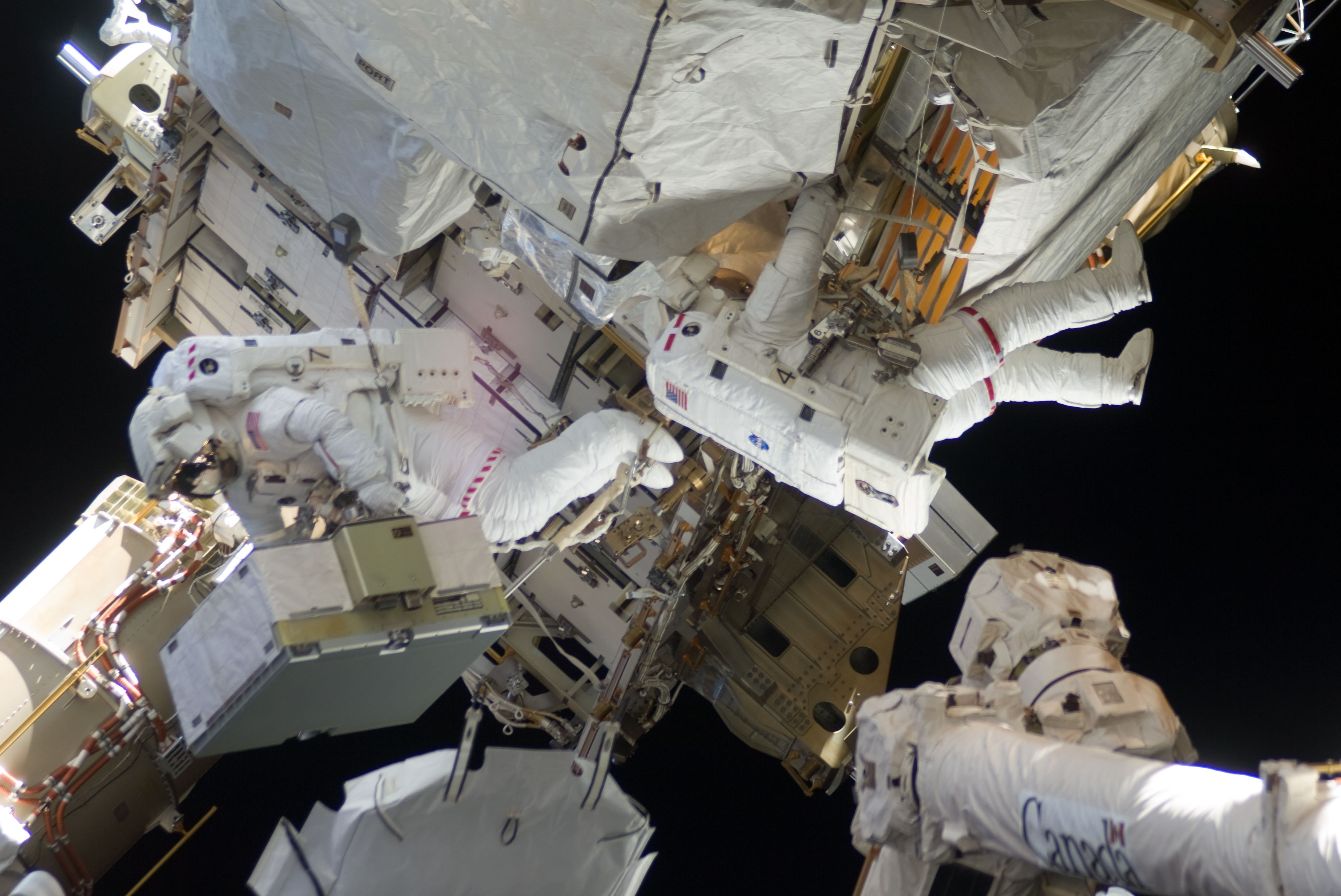
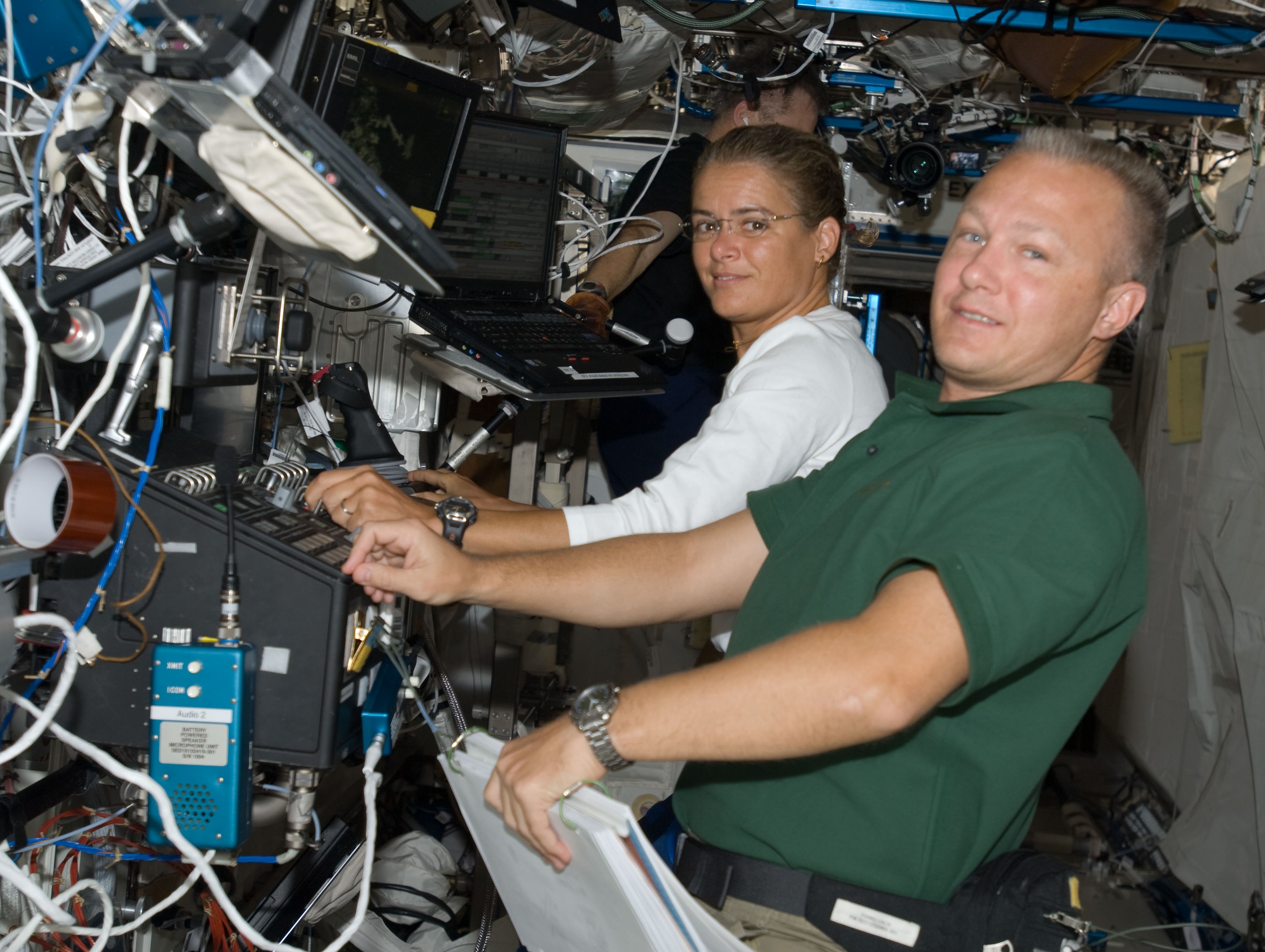
Left: Christopher J. Cassidy, left, and Thomas H. Marshburn exchange space station batteries during the mission’s fourth spacewalk. Right: Canadian Space Agency astronaut Julie Payette, left, and NASA astronaut Douglas G. Hurley operate the station’s robotic arm during the fourth spacewalk.
On Flight Day 10, Marshburn and Cassidy transferred the remaining four batteries and completed other tasks during the mission’s fourth spacewalk, lasting 7 hours and 12 minutes. Following the battery transfers, Hurley and Payette used the station’s arm to transfer the ICC to Polansky and Hurley operating the shuttle arm, who then stowed it in Endeavour’s payload bay.

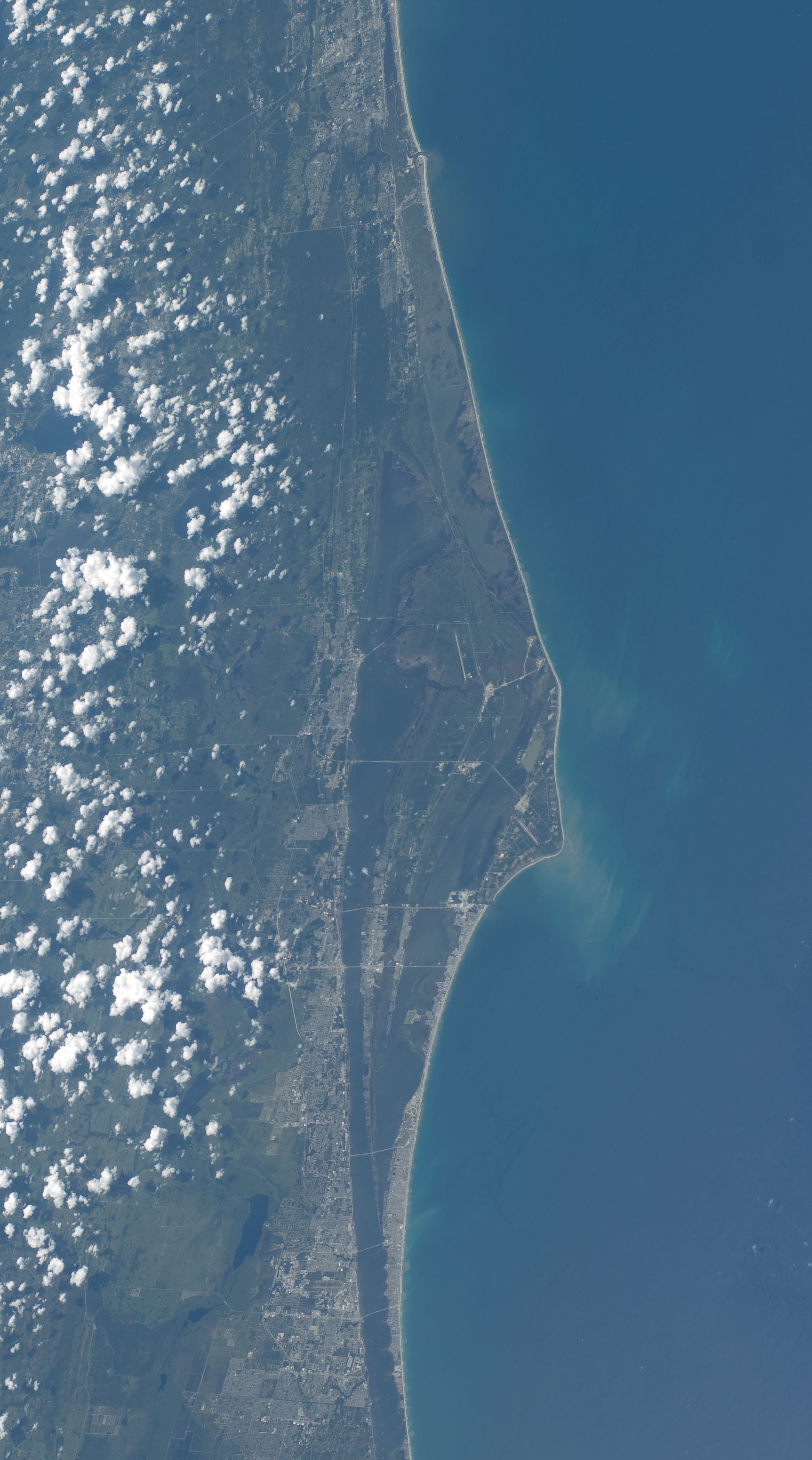
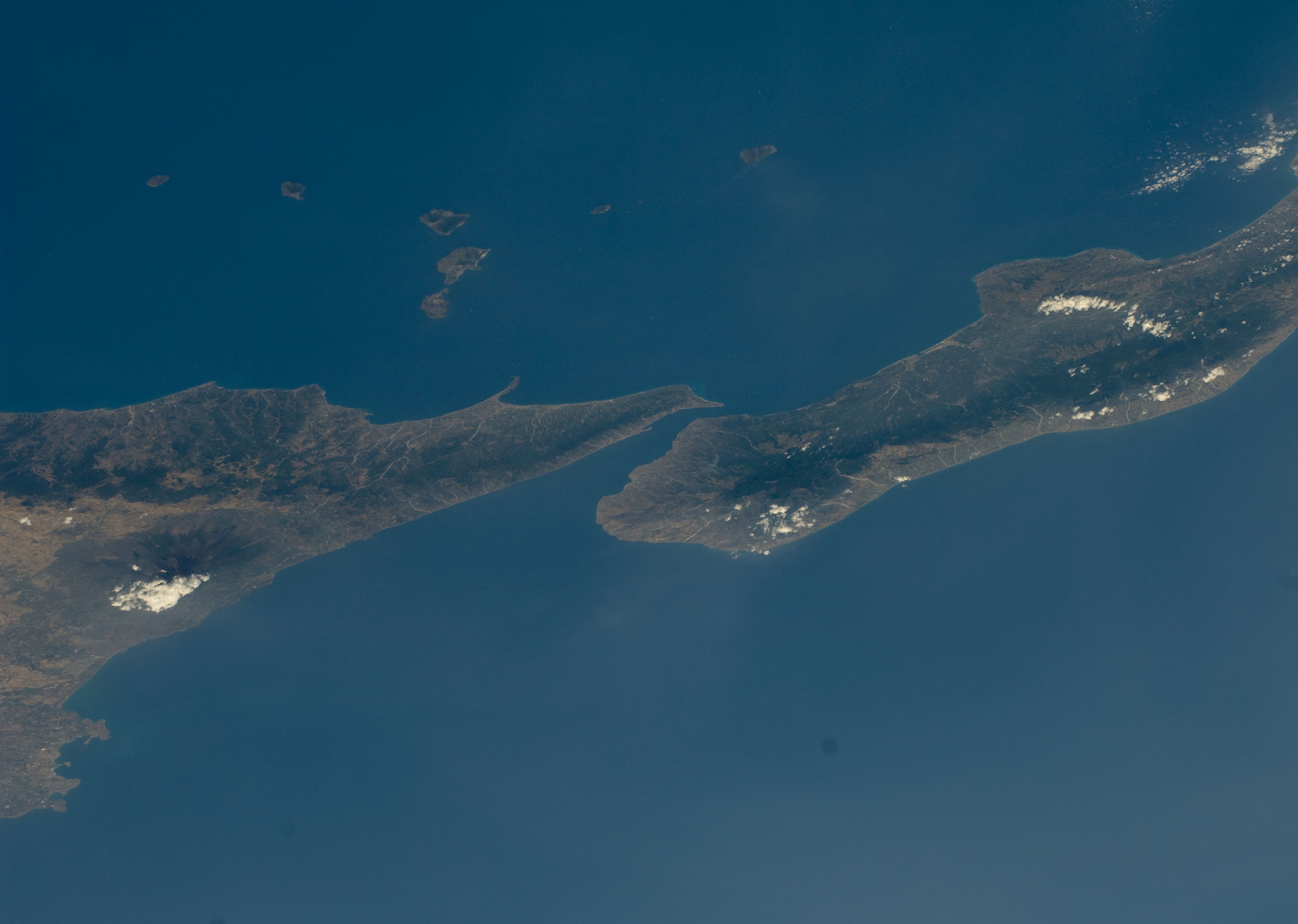
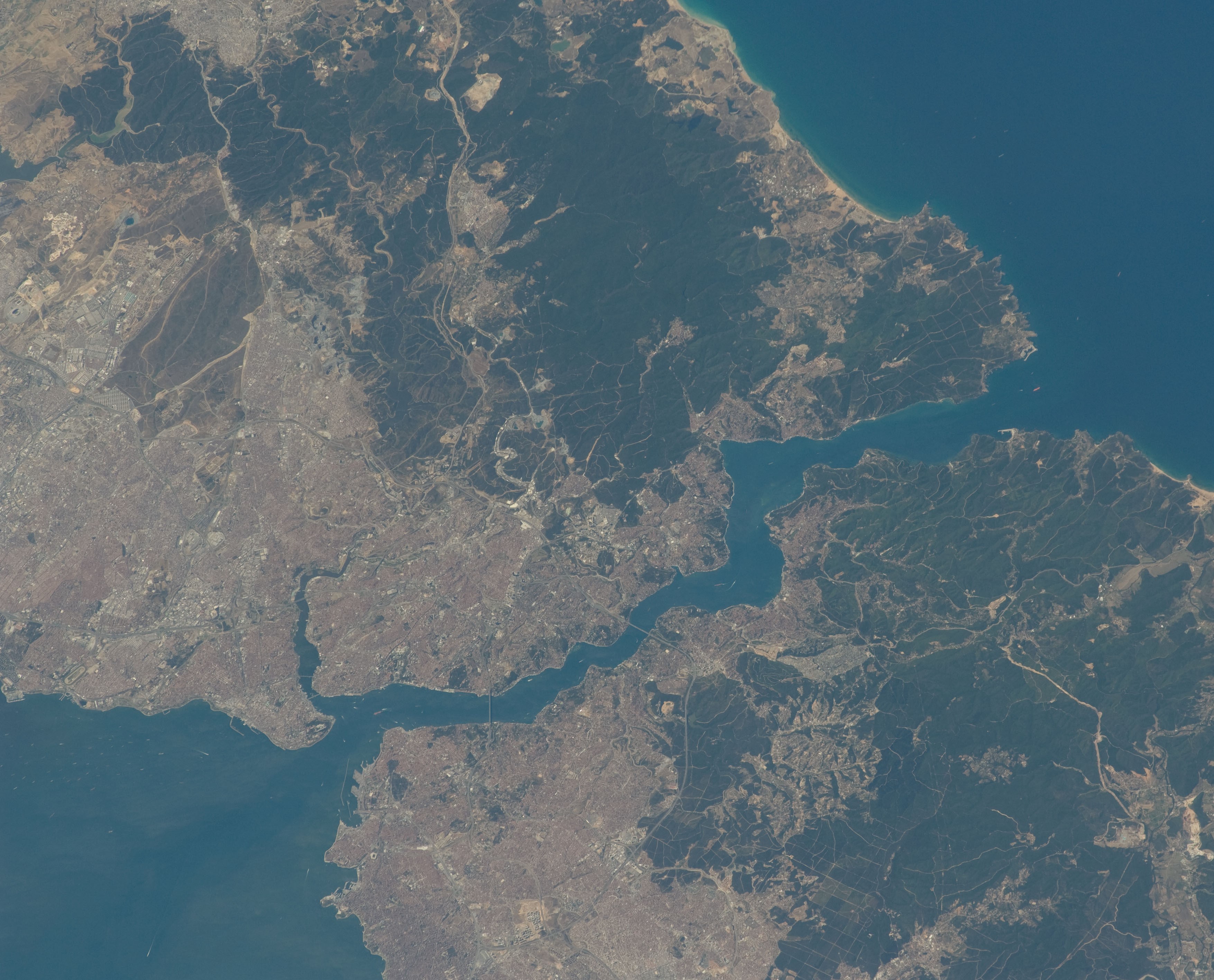
Left: The Seattle-Tacoma area. Middle left: The central Florida coast including NASA’s Kennedy Space Center. Middle right: Sicily with Mt. Etna, left, and the “toe” of Italy at right. Right: Istanbul straddling Europe, left, and Asia.
With Flight Day 11 given as a crew off duty day, many of the astronauts took part in a favorite activity: looking at and photographing the Earth. They also used the time to catch up on other activities.
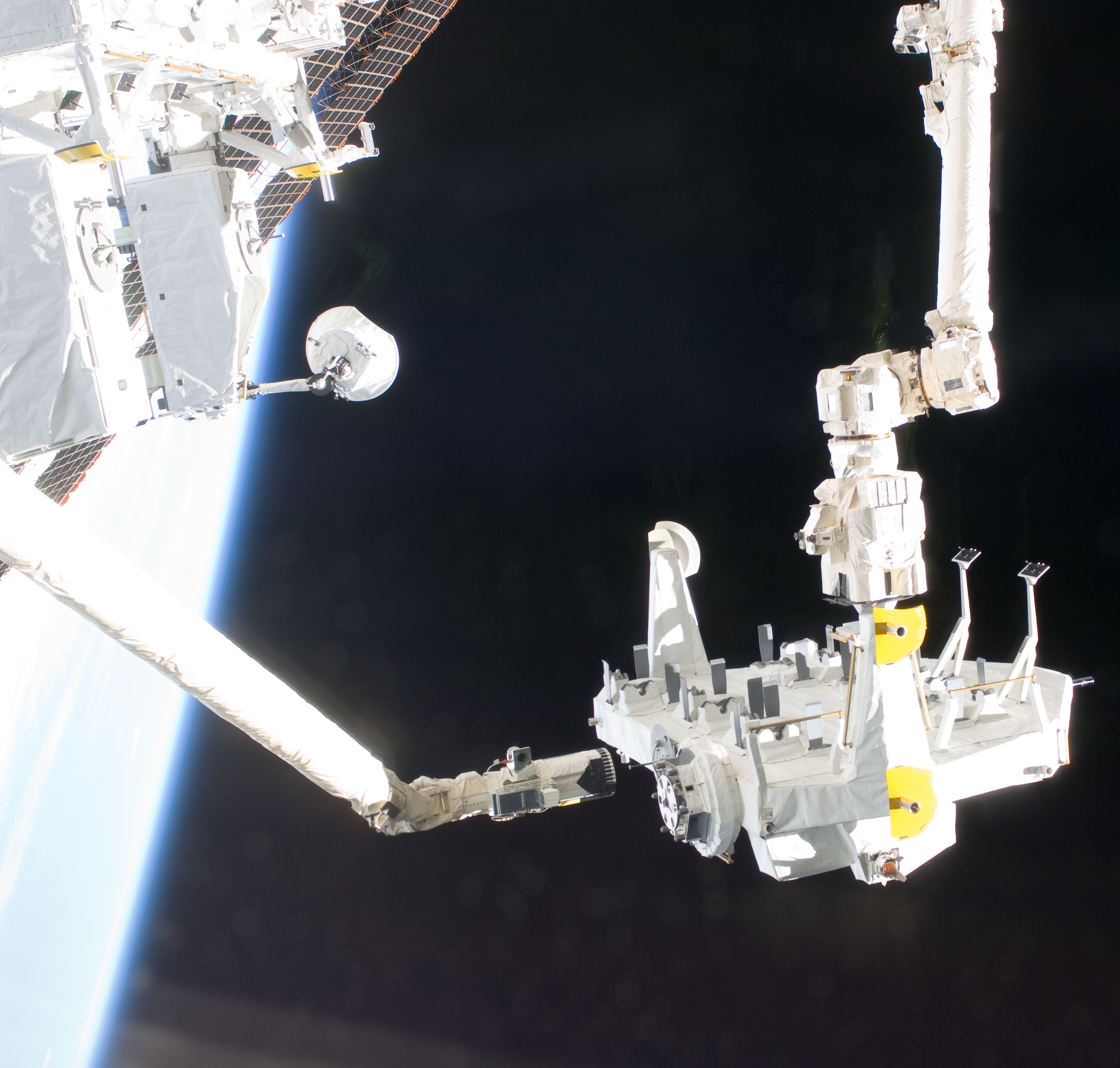
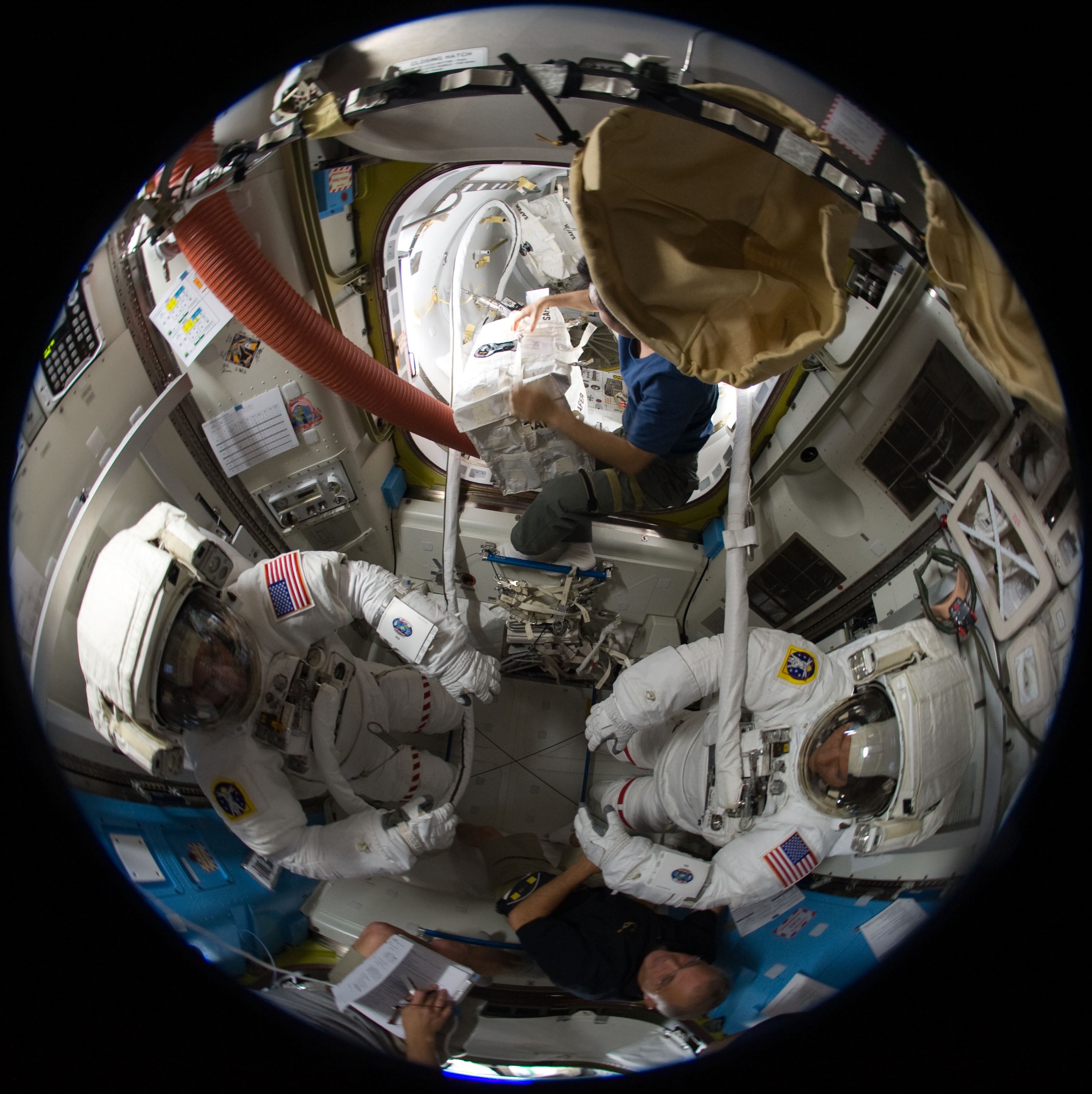
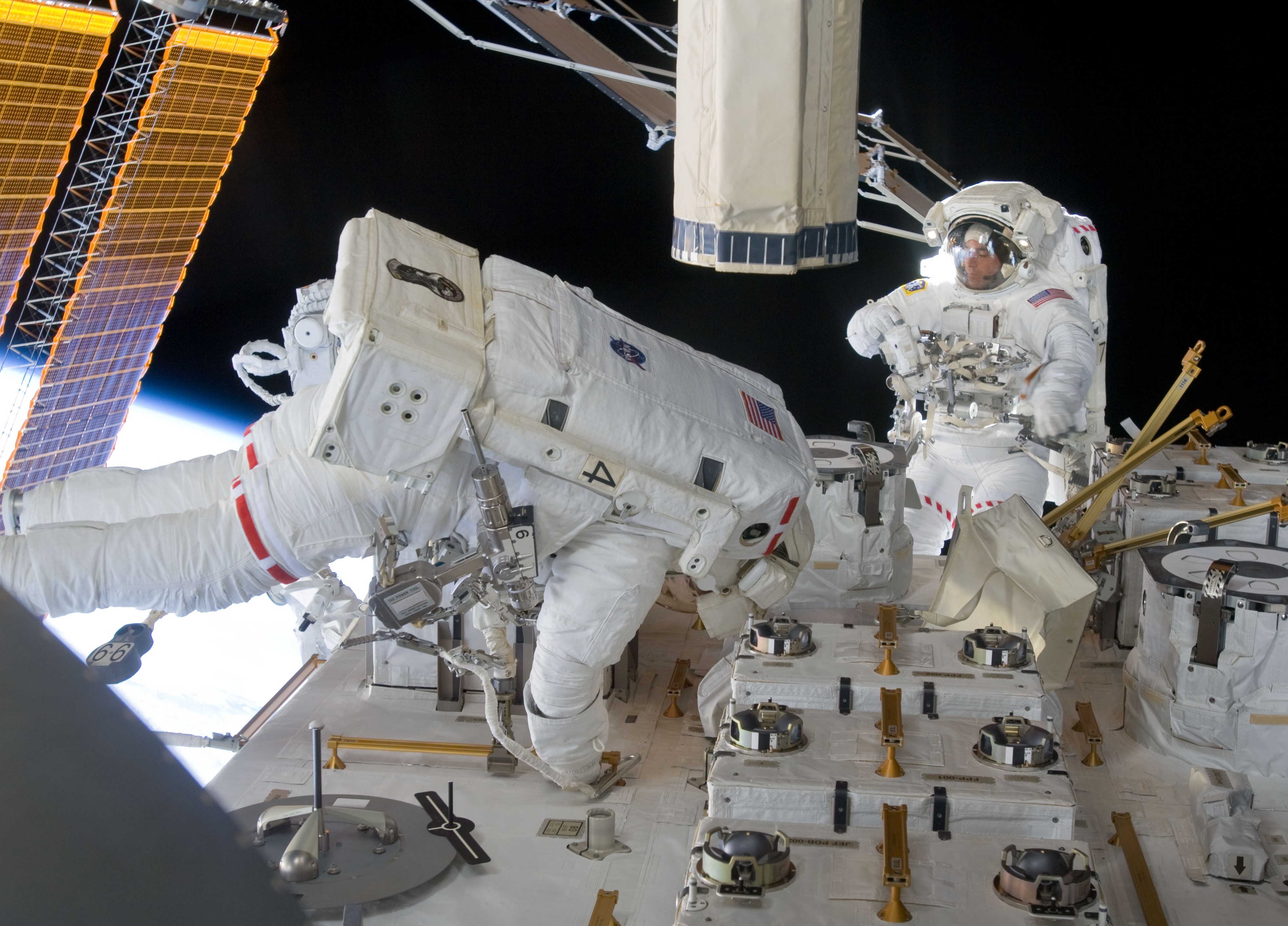
Left: Return of the empty Exposed Logistics Module to Endeavour’s payload bay. Middle: Fisheye view of Christopher J. Cassidy, left, and Thomas H. Marshburn in the U.S. Airlock preparing for the mission’s fifth and final spacewalk. Right: Marshburn, left, and Cassidy install cameras on the Kibo Exposed Facility during the fifth and final spacewalk.
First thing on Flight Day 12, Payette and Polansky returned the now empty ELM to Endeavour’s payload bay, using the station and shuttle robotic arms. The next day, Marshburn and Cassidy teamed up again for the flight’s fifth and final spacewalk. During the 4-hour 54-minute excursion, they installed a pair of cameras on the Kibo module to help guide future H-II Transfer Vehicle (HTV) cargo spacecraft, the first planned to arrive in September 2009. They also completed a few get ahead tasks. Their excursion brought the total spacewalking time for the mission to 30 hours 30 minutes and marked only the second time that a shuttle mission to the space station completed five spacewalks.

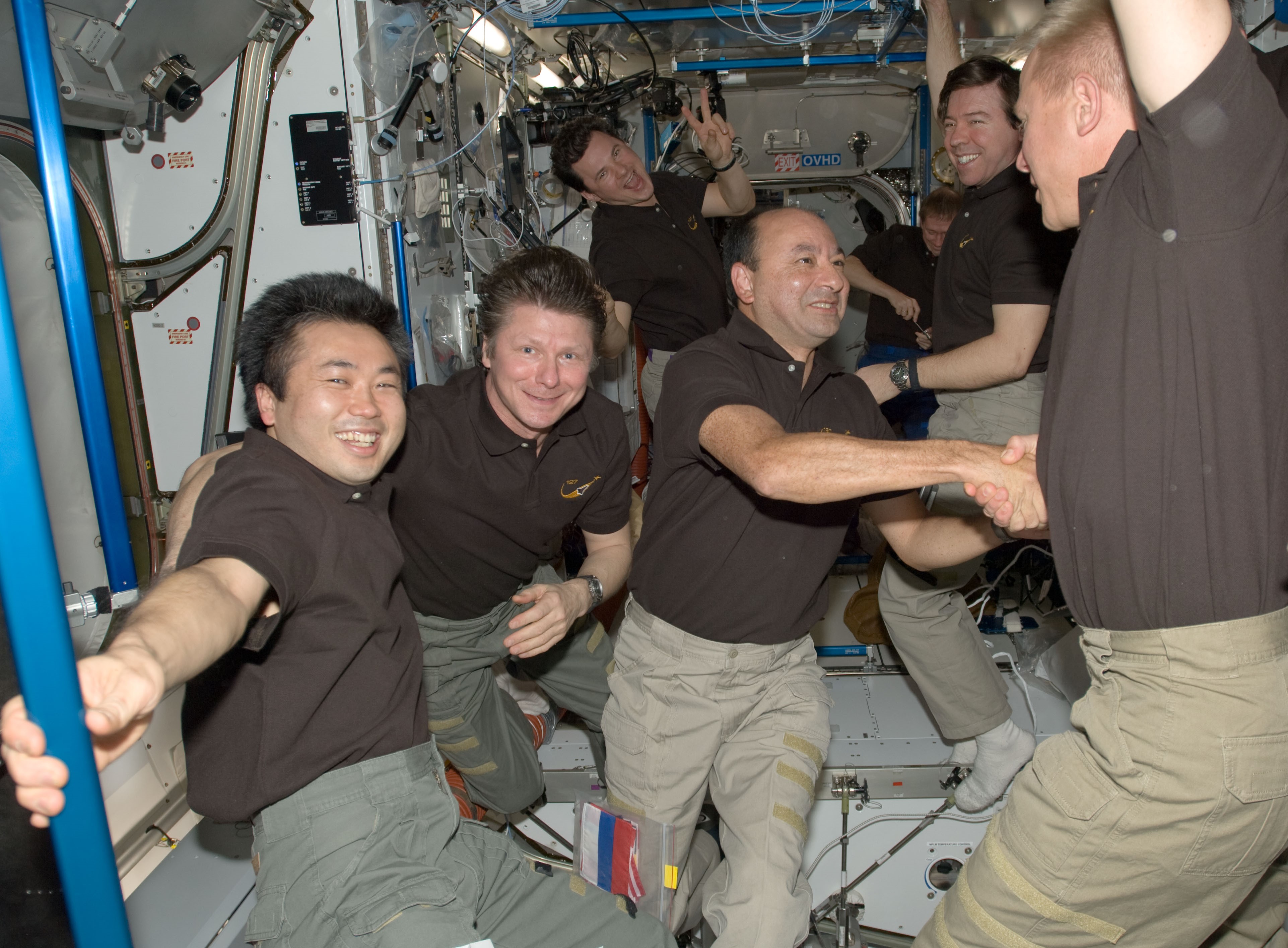
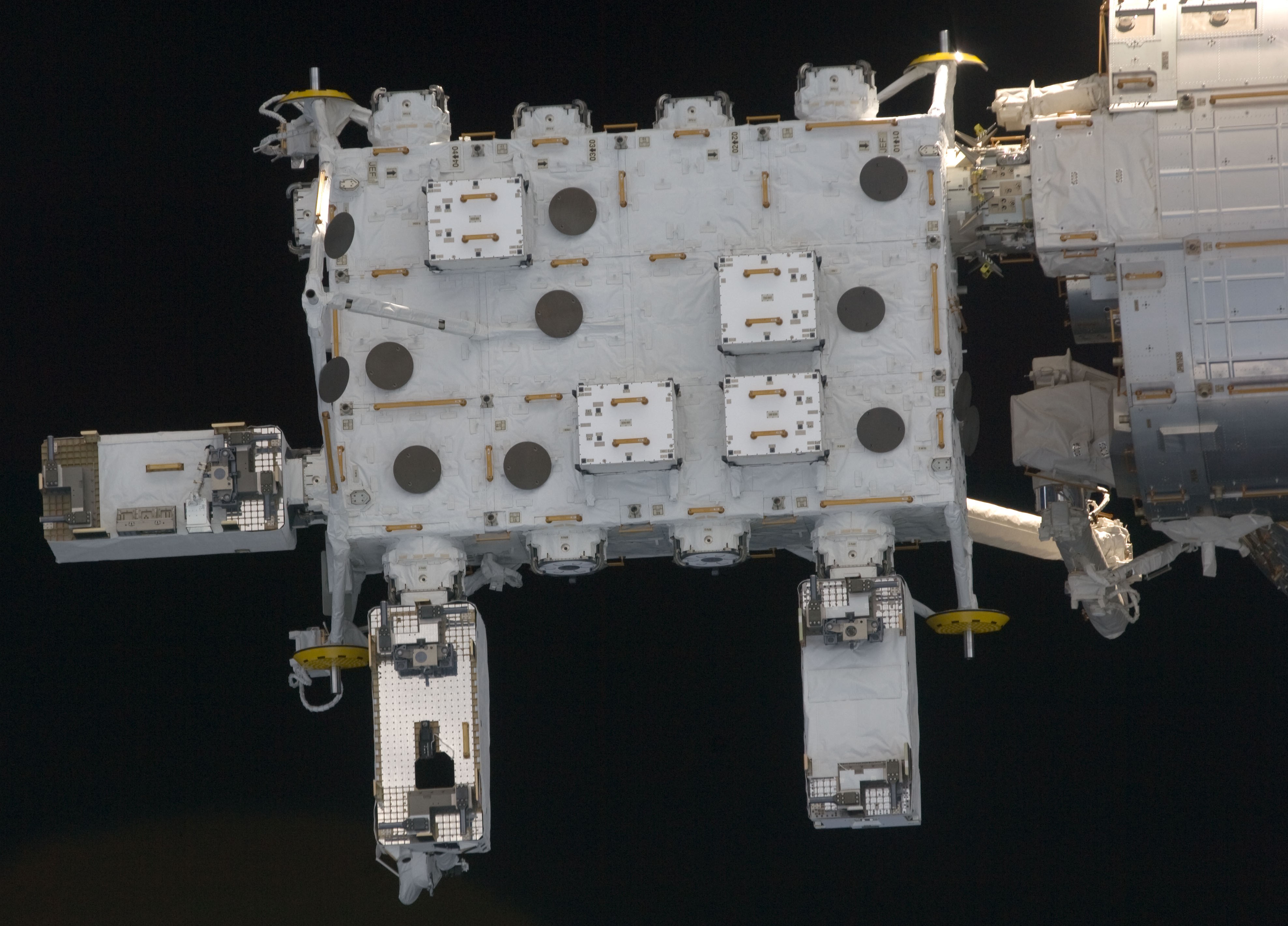
Left: The 13 members of Expedition 20 and STS-127 pose for a final photograph before saying their farewells. Middle: The crew members exchange farewells, with Koichi Wakata of the Japan Aerospace Exploration Agency, left, appearing a little reluctant to leave after spending 133 days aboard the space station. Right: Photograph of the newly installed Exposed Facility on the Kibo Japanese Experiment Module.
On July 28, the mission’s 14th day, the 13-member joint crew held a brief farewell ceremony, parted company, and closed the hatches between the two spacecraft. With Hurley at the controls, Endeavour undocked from the space station, having spent nearly 11 days as a single spacecraft. Hurley completed a flyaround of the station, with the astronauts photographing it to document its condition. A final separation burn sent Endeavour on its way.
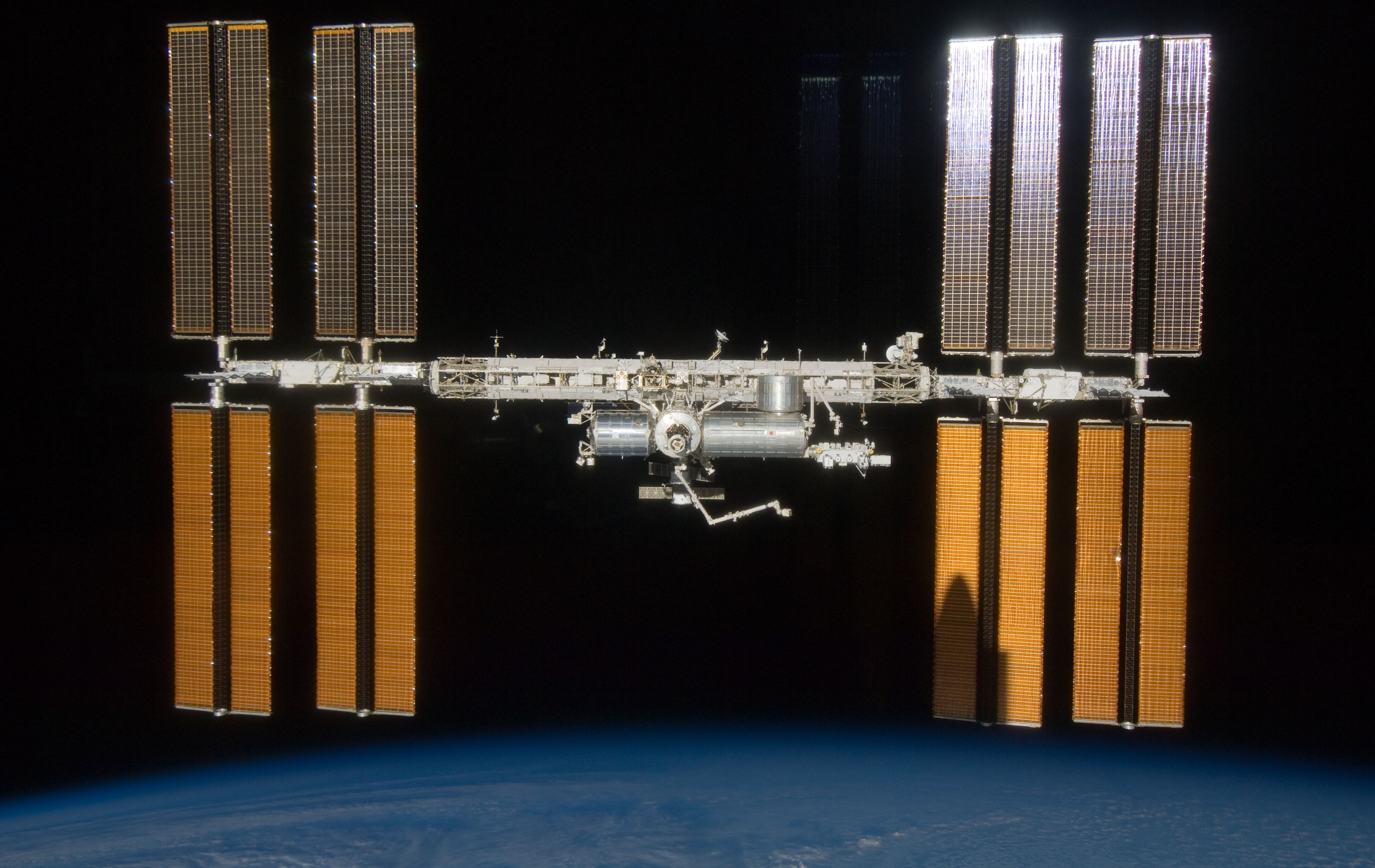
The International Space Station, with the newly added Exposed Facility and its first payloads, as seen from Endeavour during the departure flyaround. Endeavour casts its shadow on the solar arrays.
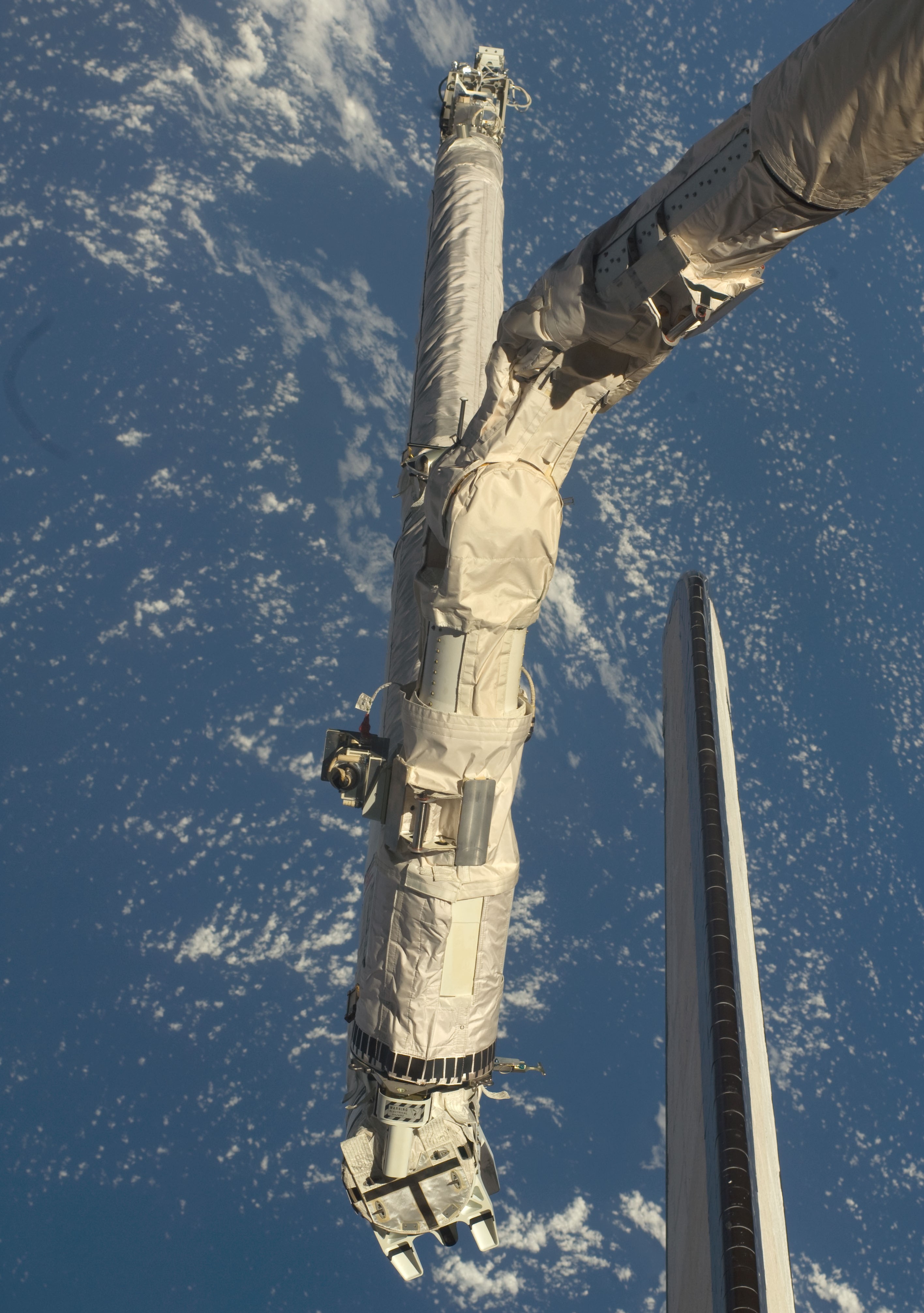
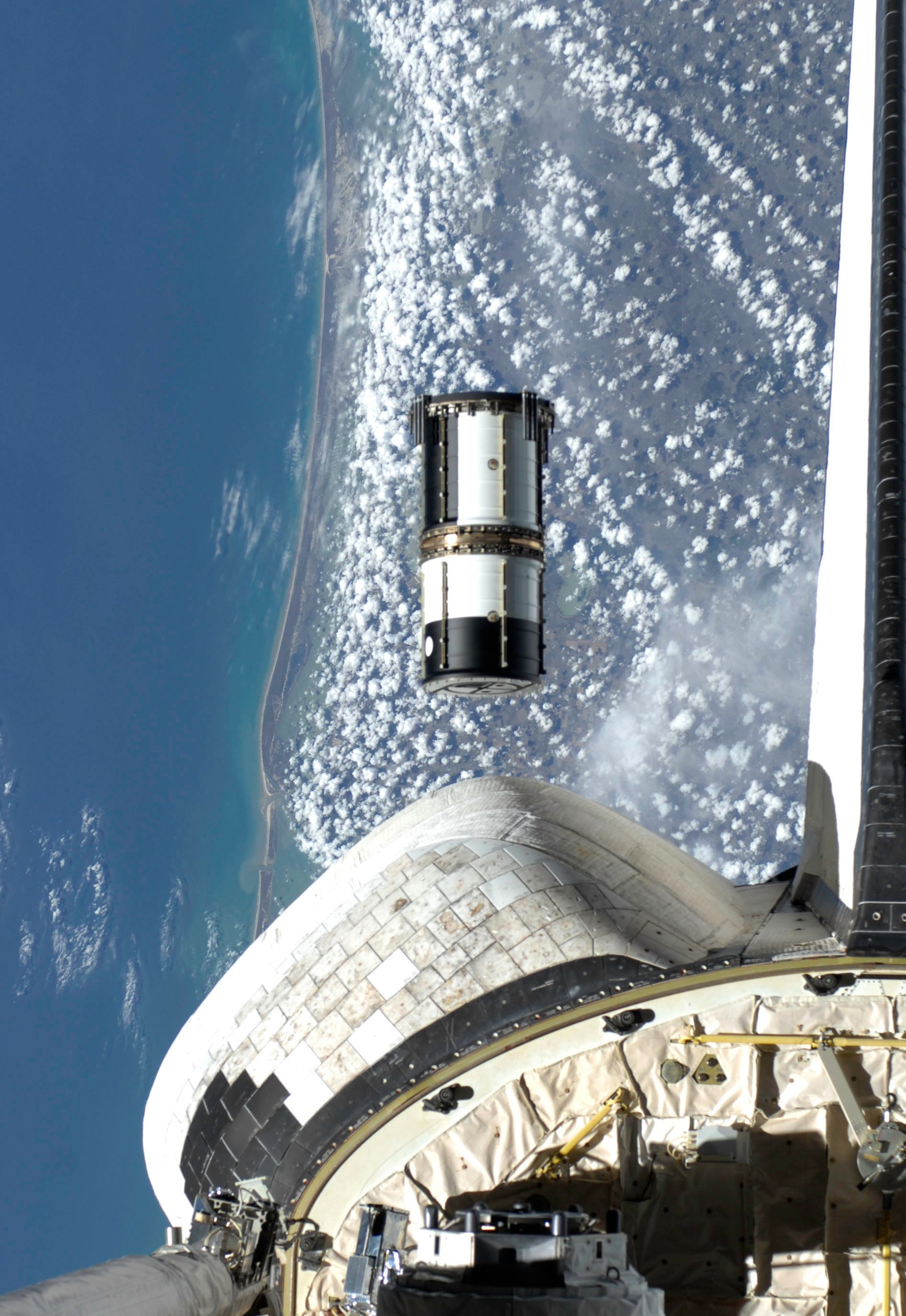
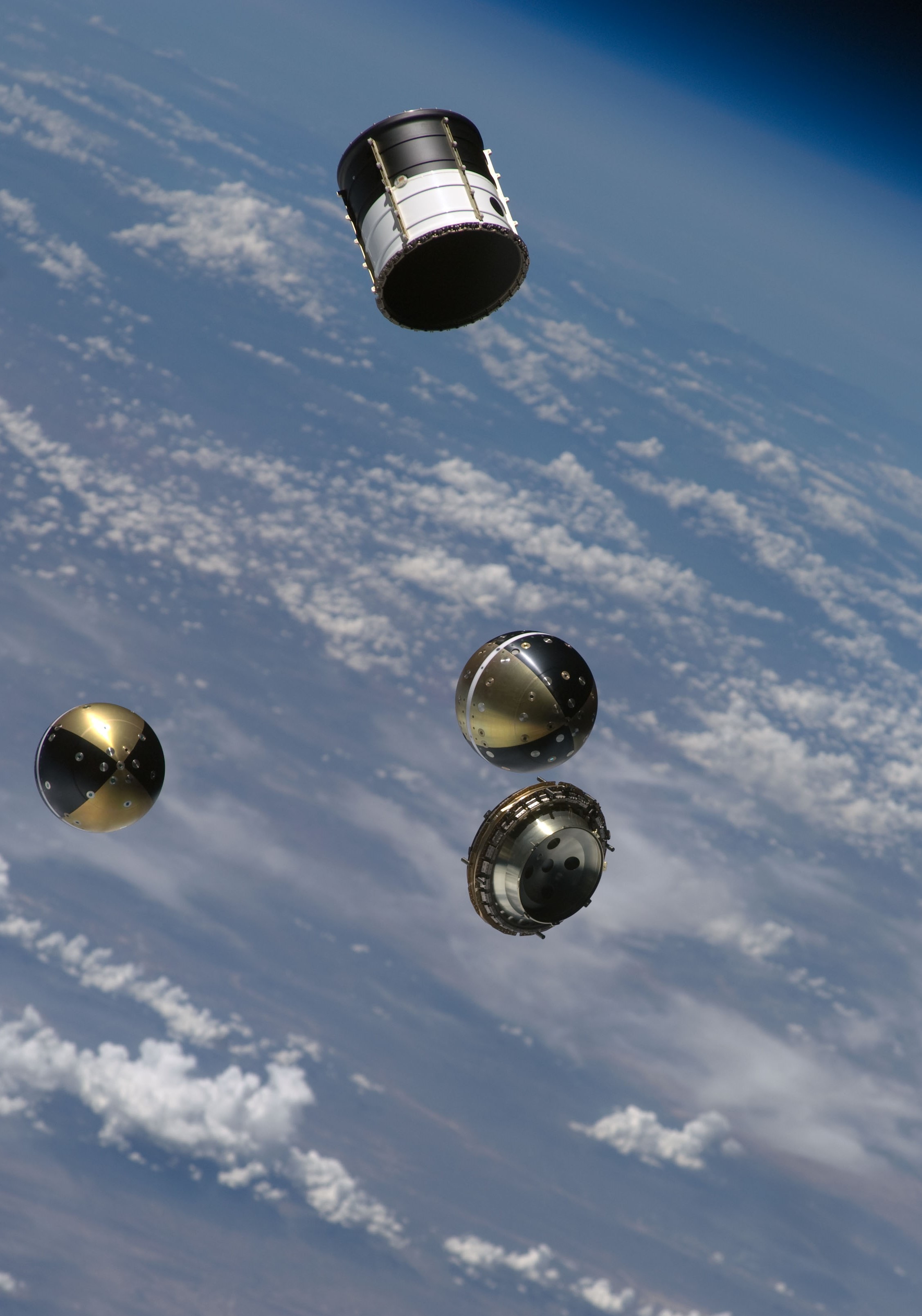
Left: The shuttle’s robotic arm grapples the Orbiter Boom Sensor System for the late inspection of Endeavour’s heat shield. Middle: Deploy of the DRAGONSAT microsatellite. Right: Deploy of the ANDE microsatellites.
The next day, Polansky, Payette, and Hurley used the shuttle’s arm to pick up the OBSS and perform a late inspection of Endeavour’s thermal protection system. On Flight Day 16, the astronauts deployed two satellites. The first, called Dual RF Astrodynamic GPS Orbital Navigation Satellite, or DRAGONSAT, designed by students at the University of Texas, Austin, and Texas A&M University, College Station, consisted of a pair of picosatellites to look at independent rendezvous of spacecraft using GPS. The second, called Atmospheric Neutral Density Experiment-2, or ANDE-2, consisted of a set of Department of Defense microsatellites to look at the density and composition of the atmosphere 200 miles above the Earth. Polansky and Hurley tested Endeavour’s reaction control system thrusters and flight control surfaces in preparation for the next day’s entry and landing. The entire crew busied themselves with stowing all unneeded equipment.
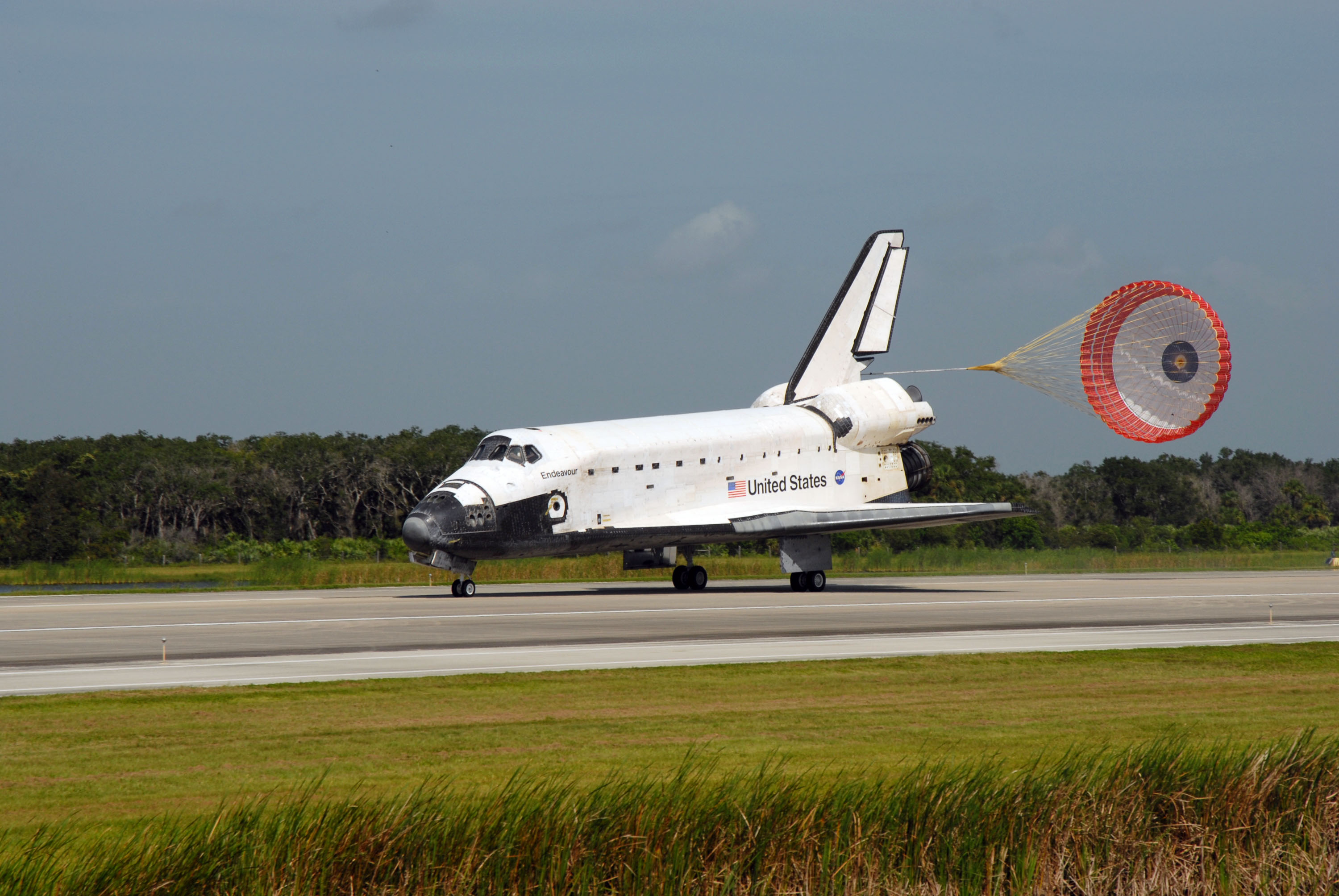
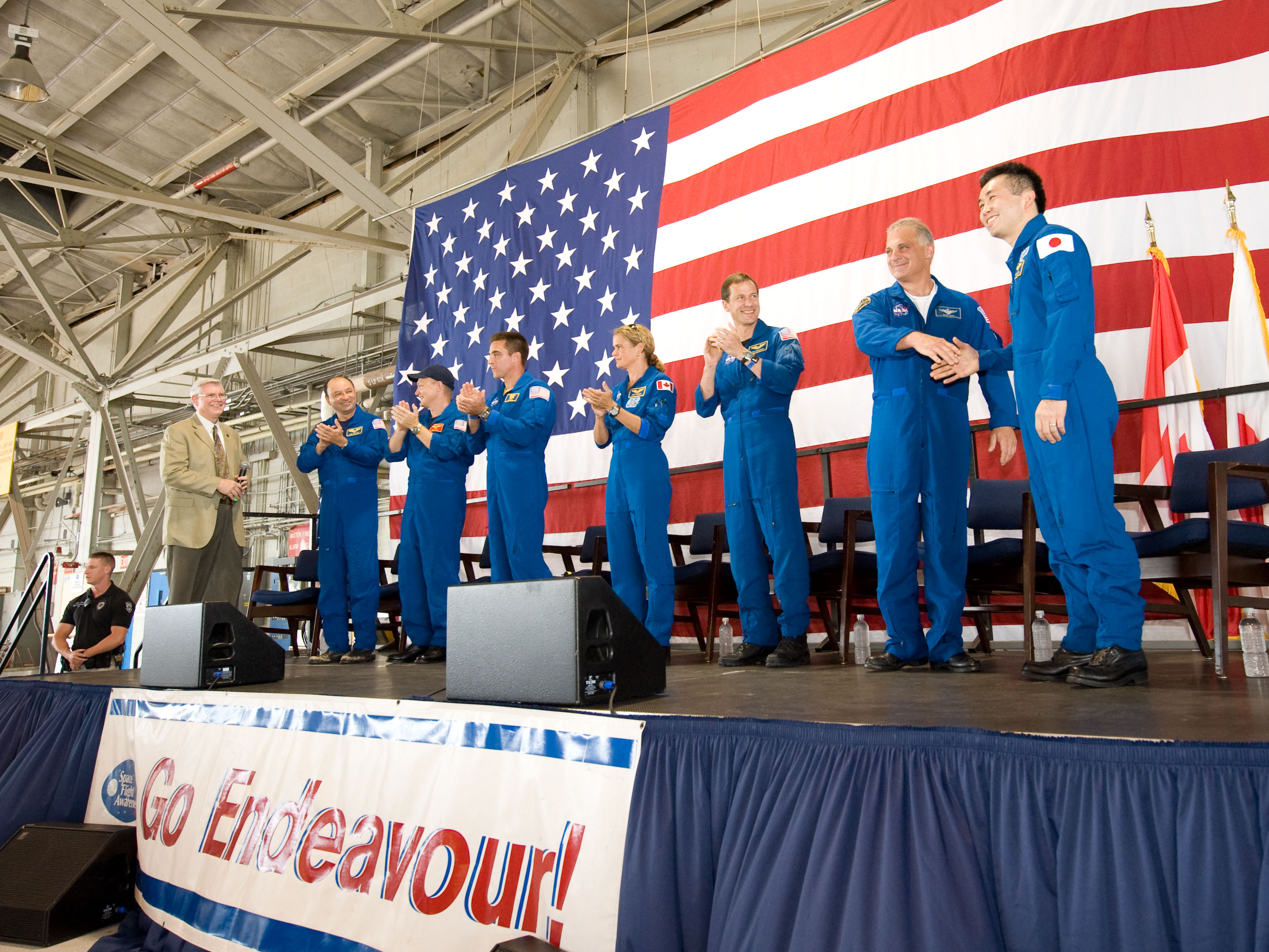
Left: Endeavour touches down on the Shuttle Landing Facility at NASA’s Kennedy Space Center in Florida. Right: The welcome home ceremony for the STS-127 crew at Ellington Field in Houston.
On July 31, the astronauts closed Endeavour’s payload bay doors, donned their launch and entry suits, and strapped themselves into their seats, a special recumbent seat for Wakata who had spent the last four months in weightlessness. Polansky fired Endeavour’s two Orbital Maneuvering System engines to bring them out of orbit and heading for a landing half an orbit later. He guided Endeavour to a smooth touchdown at KSC’s Shuttle Landing Facility, capping off a very successful STS-127 mission of 15 days, 16 hours, 45 minutes. They orbited the planet 248 times. Wakata spent 137 days, 15 hours, 4 minutes in space, completing 2,166 orbits of the Earth. Workers at KSC began preparing Endeavour for its next flight, STS-130 in February 2010.
Enjoy the crew narrate a video about the STS-127 mission.
What's Your Reaction?
































